Exclusiv


MAGAZIN € 5,80
DIE
STAATSOPER
© Jeff Mangione ‹
VIENNA EXCLUSIVE Als „Carmen“ in der Wiener Staatsoper As “Carmen” at the Vienna State Opera ELINA GARANCA An den führenden Opernhäusern der Welt zuhause At home in the world’s premier opera houses GÜNTHER GROISSBÖCK "Das Erste Haus am Ring" “The first house on the Ring” - The Vienna State Opera
WIENER
Wien wien-exclusiv.com austria-exclusive.com
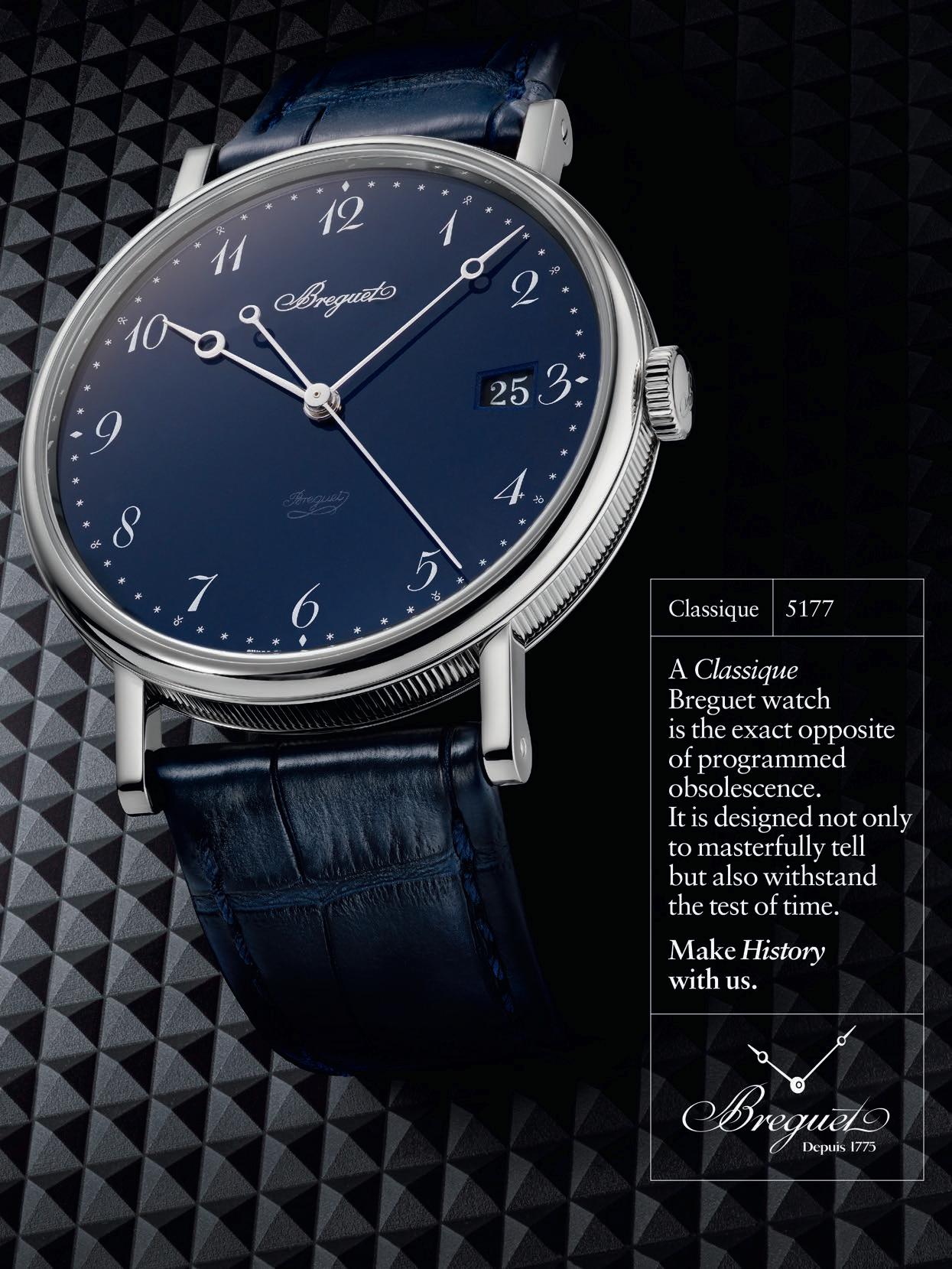
Gaetano Donizetti 21., 24. Februar, 7., 10. März..

FIDELIO Ludwig van 22., 25. Februar, Beethoven 2., 4. März
DIE ENTFÜHRUNG INS Wolfgang Amadeus 27., 28. Februar, ZAUBERREICH Mozart, Gerald 8., 12., 14., 19., 20., Resch 21. März, 17., 18., 23. April, 30. Mai 1., 5., 6., 11., 19., 25. Juni..
SOLISTENKONZERT Andreas Schager 28. Februar..
LA CENERENTOLA Gioachino Rossini 3., 5., 8., 12. März..
LE NOZZE DI FIGARO Wolfgang 9., 11., 13., 15., 17., Amadeus Mozart 19., 23., 26. März, 6., 10., 13., 17. Juni..
LA FILLE MAL GARDÉ Frederick Ashton 16., 27., 30. März.. TOSCA Giacomo Puccini 25., 28., 31. März..
Johann Strauss 1., 4., 6. Jänner LA FILLE DE RÉGIMENT Gaetano Donizetti 2. Jänner 2023..
BARBIERE DI SIVIGLIA Gaetano Donizetti 3., 7., 10., 13., 15. Jänner
Richard Strauss 5., 8., 11. Jänner.. TSCHICK Ludger Vollmer 8., 15. Jänner, 1. Februar.. 14., 18. Mai, 10., 16. Juni..
HIMMEL Ballett 9., 12., 20. Jänner, 3., 10., 13. April..
PHILHARMARMONIKER Kammermusik 14. Jänner, 25. Februar, 15. April, 6., 20. Mai 24. Juni.. AIDA Giuseppe Verdi 14., 18., 21., 24. Jänner.. OPERNSCHULE Konzert 17. Jänner.. LA BOHÉME Giacomo Puccini 19., 22., 25., 28., 31. Jänner..
John Cranko 23., 27., 30. Jänner, 14., 18., 22., 24. März.. DON GIOVANNI Wolfgang 26., 29. Jänner, Amadeus Mozart 1., 3., 6. Februar..
DIE FLEDERMAUS
IL
ELEKTRA
IM SIEBTEN
WIENER
ONEGIN
SALOME Richard Strauss 2., 4., 8., 10., 12. Februar, 21., 24., 26., 29. April LA TRAVIATA Giuseppe Verdi 5., 7., 9., 11. Februar.. LIEBESLIEDER 13., 18., 19. Februar, 1., 6., 9. März.. DIE ZAUBERFLÖTE Wolfgang 17. Februar.. für Kinder Amadeus Mozart TRISTAN UND ISOLDE Richard Wagner 19., 23., 26. Februar.. L´ELISIR D´AMORE
WOZZECK Alban
IL RITORNO D´ULISSE Claudio Monteverdi
IN PATRIA
PARSIFAL Richard
LOHENGRIN Richard
CARMEN Georges
GOLDBERG VARIATIONEN Ballett
1., 5., 9., 15., 19., 22., 25., 29. Mai MANON Jules Massenet 30. April, 4., 7., 10., 13. Mai MATINEE DER 1. Mai.. BALLETTAKADEMIE VON DER LIEBE TOD DAS Gustav Mahler 6., 8., 11., 16. Mai.. KLAGENDE LIED DON PASQUALE Gaetano Donizetti 17., 20., 23., 26. Mai.. DIALOGUES DES CARMÈLITES 21., 24., 27., 30. Mai 2. Juni.. LADY MACBETH VON Dimitri 28., 31. Mai, 3., 8., MZENSK Schostakowitsch 12. Juni.. DAS RHEINGOLD Richard Wagner 1. Juni.. DIE WALKÜRE Richard Wagner 5., 22. Juni.. DIE JAHRESZEITEN Martin Schläpfer 5., 7., 9., 14., 16. Juni.. SIEGFRIED Richard Wagner 11., 25. Juni.. CAVALLERIA RUSTICANA/PAGLIACCI Piotro Mascagni, 15., 19., 24., 27. Juni.. Ruggero Leoncavallo DIE GÖTTERDÄMMERUNG Richard Wagner 18., 30. Juni.. MADAMA BUTTERFLY Giacomo Puccini 20., 23., 26., 29. Juni.. DAS RHEINGOLD Richard Wagner 21. Juni.. DON QUIXOTE Rudolf Nurejew 28. Juni..
12., 14., 18. Mai..
Berg 29. März, 1., 5. April..
31. März, 2., 4., 8., 11.,
14. April
Wagner 12., 16. April..
Wagner 15., 20., 23. April..
Bizet 19.,22., 25., 28. April..
26. April,
PROGRAMM WIENER STAATSOPER
© Michael Poehn
Hervorgegangen aus einem kleinen Lederwarengeschäft steht der Familienbetrieb seit 1889 für Exzellenz und perfekten Service. Nach der umfassenden Renovierung der damals heruntergekommenen Räumlichkeiten stammten die ersten Kollektionen 1976 vom deutschen Modeschöpfer Ermano Sens. Schritt für Schritt fanden die bekanntesten Fashion Designer der Welt Eingang in das Sortiment, Popp & Kretschmer entwickelte sich zu einem der größten Modehäuser in Wien. Dennoch blieb der Fokus des Traditionsbetriebes immer auf persönlichem Kontakt und perfektem Service für die vielfältige Kundschaft. n
DER PREMIUMSHOP NÄCHST DER OPER
IM PALAIS TODESCO, WO SICH BEREITS HUGO VON HOFFMANNSTHAL, FERDINAND VON SAAR, HENRIK IBSEN UND JOHANN STRAUSS SOHN ZUM KÜNSTLERSALON TRAFEN, SOLLTE 1889 EINER DER EXKLUSIVSTEN WIENER MODESALONS ENTSTEHEN. POPP &
POPP & KRETSCHMER COUTURESALON
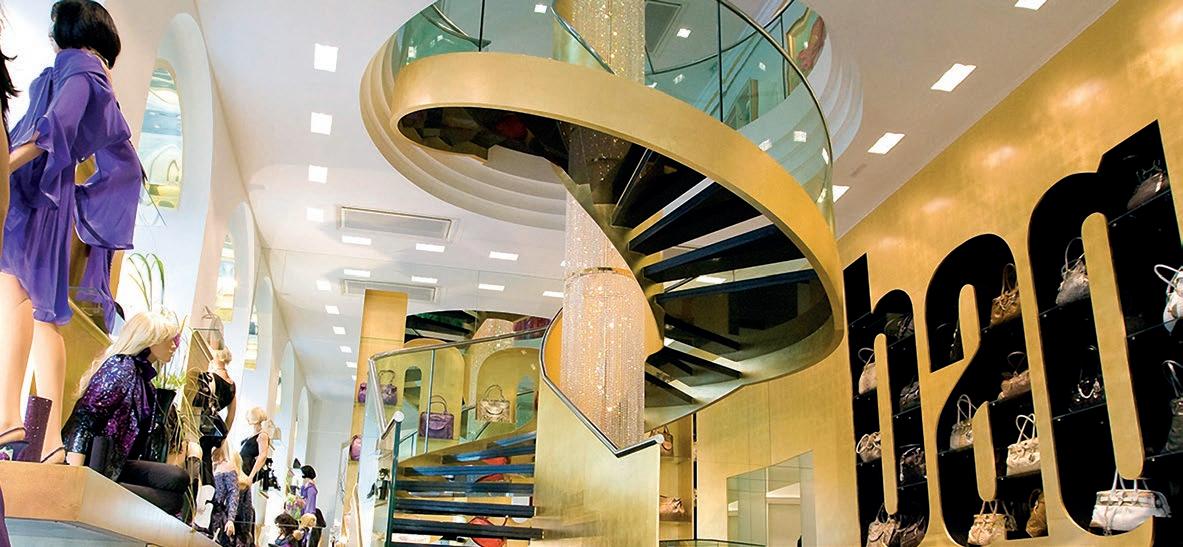
AT PALAIS TODESCO, WHERE HUGO VON HOFFMANNSTHAL, FERDINAND VON SAAR, HENRIK IBSEN AND JOHANN STRAUSS SOHN MET FOR THE ARTIST SALON, ONE OF THE MOST EXCLUSIVE VIENNESE FASHION SALONS WAS TO BE CREATED IN 1889.
Originating from a small leather goods shop, the family business has stood for excellence and perfect service from the beginning. After the renovation of the then dilapidated premises, the first collections came 1976 from the German fashion designer Ermano Sens. Step by step, the world's most famous fashion designers found their way into the range, and Popp & Kretschmer developed into one of the largest fashion houses in Vienna. Nevertheless, the focus of the traditional company always remained on personal contact and perfect service for the diverse clientele. n
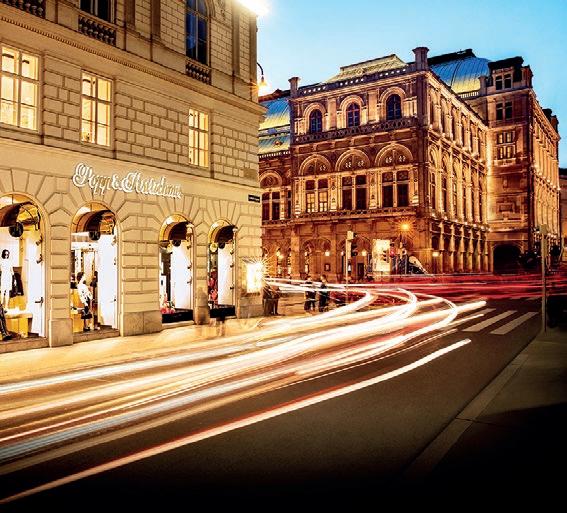
KRETSCHMER MODEHANDELS GMBH Kärntnerstraße 51 • 1010 Wien • +43 512 64 21 office@popp-kretschmer.at • www.popp-kretschmer.at
THE PREMIUM BOUTIQUE NEXT TO THE OPERA


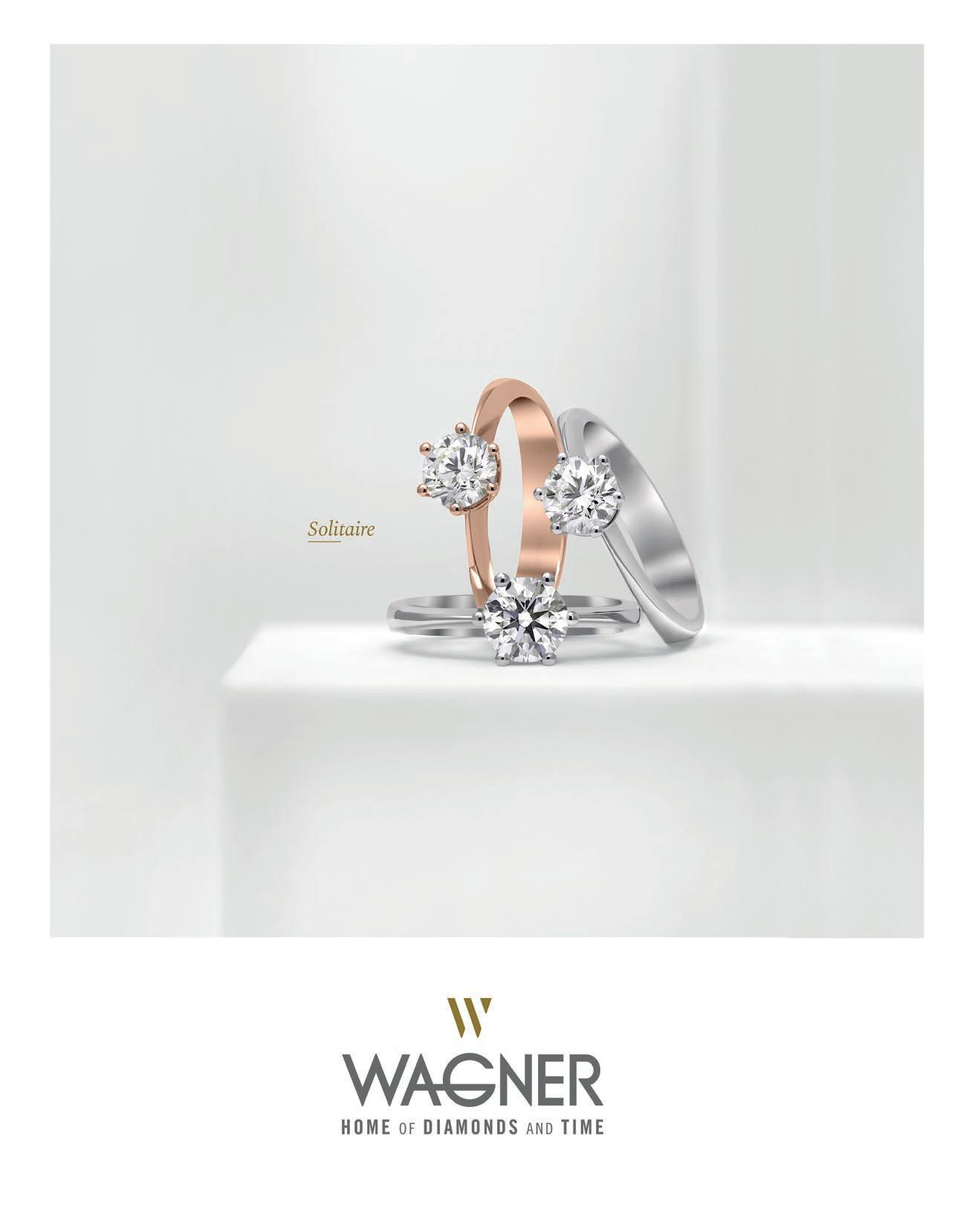
 © Starpix
Alexander Tuma
© Starpix
Alexander Tuma
ELĪNA GARANČA
Die „Amneris“ aus „Aida“ ist mein Mount Everest, mein Höhepunkt
Ein lange Beziehung hat die geborene Lettin mit der Wiener Staatsoper, bereits 2003 wurde sie Ensemblemitglied und hält seither dem Hause stets die Treue. Obwohl auf allen Bühnen der Welt zu Hause, fühlt sie sich in Wien besonders wohl
Eine mit Garanča in der Titelpartie und Piotr Beczała als Don José besetzte „Carmen“ dominiert den Spielplan der aktuellen Saison. Experten meinen, der Mezzosopran der Künstlerin und ihr szenischer Ausdruck seien dabei in besonderem Einklang. Garanča selbst sieht das aber gar nicht so: Sie versuche sich eher von Lust und Idealen zu trennen. „Auch da Carmen im Gegensatz zu mir keine Kinder hat, entfremden wir uns. Denn mit Familie und Kindern verändert sich der eigene Egoismus", sagt sie. Sie würde aber gerne mit Carmen über vieles sprechen, vor allem über ihre Vergangenheit. „Wir alle sind aus dem, was wir waren, geworden – und darüber wissen wir in ihrem Fall nichts“, sagt sie.
Staatsoperndirektor Bogdan Roščić hat ihr eine weitere Paraderolle mit der Wiederaufnahme der „Aida“ angeboten. „Die Amneris ist mein Mount Everest, mein Höhepunkt. Danach kann ich aufhören“, schmunzelt Garanča, die mit Jonas Kaufmann als Radamès diese Opernabende gestaltet.

Die Künstlerin dachte kürzlich öffentlich über die Parallelen der beiden Rollen nach: „Es gibt sehr viele Böse im Sopranrepertoire: Die Carmen, die Dalila, die Kundry und viele andere.“ Sie denke aber auch, dass viele Reaktionen von Amneris impulsiver Natur seien und "gar nicht so kalkuliert". Und genau dies seien die Facetten, die sie an dieser Rolle am meisten interessieren. Zwei Jahre hat sie sich vorbereitet. "Die Amneris steht schon immer auf meiner Bucket List", erzählt sie.
Ein Meilenstein sei auch die Kundry in "Parsifal" und gleichzeitig auch ihr Wagner-Debüt an der Wiener Staatsoper gewesen. „Seit 2003 stand ich mehr als 150 Mal auf dieser Bühne“, so die Mezzosopranistin. „Immer, wenn ich dort bin, denke ich, wie viele legendäre Dirigenten und Sänger das Haus beherbergt hat, es macht mich sehr stolz. An der Staatsoper kann man nach den Sternen greifen.“
Erst kürzlich hat sie als erste Frau den Medien-Sonderpreis des Österreichischen Musiktheaterpreises erhalten. Sie setzt sich selbst auch sehr für die Künstlerförderung ein und engagiert sich gemeinsam mit ihrem Mann Karel Mark Chichon mit "ZukunftsStimmen" für junge Talente. Garanča selbst wurde in die „Welt der Musik hineingeboren“, die Mutter konnte als Professorin für Gesang für die richtige Einschulung sorgen, der Vater als Dirigent Halt geben. n
ELĪNA GARANČA SORGT FÜR AUSVERKAUFTE HÄUSER RUND UM DEN ERDBALL. IN WIEN GIBT ES HEUER BESONDEREN GESPRÄCHSSTOFF, DENN SIE SPRICHT DAVON, IM BERÜHMTEN HAUS AM RING GLEICH ZWEI MAL „EINE BÖSE ZU SEIN.“
Elina Garanca ›
The role of “Amneris” from Aida is my Mount Everest, my pinnacle
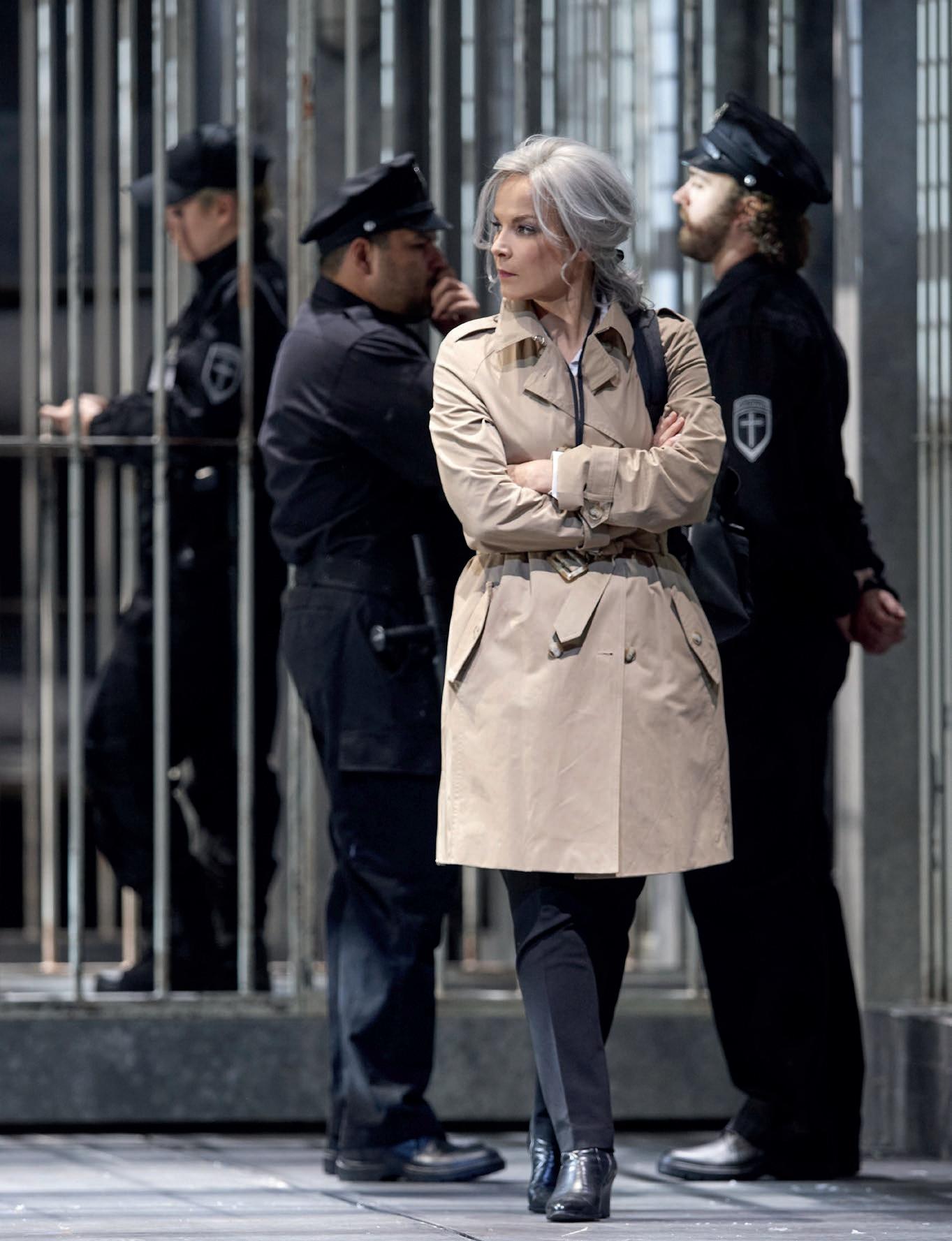 © Michael Poehn
© Michael Poehn
ELĪNA GARANČA IS A NAME THAT GUARANTEES SOLD-OUT PERFORMANCES AROUND THE GLOBE. AND WHEN IT COMES TO GARANČA, THERE’S PLENTY TO TALK ABOUT IN VIENNA THIS YEAR, AS SHE HERSELF HAS SPOKEN ABOUT "BEING A BITCH" ON TWO OCCASIONS AT THE FAMOUS FIRST HOUSE ON THE RING.
The Latvian-born singer has enjoyed a long relationship with the Vienna State Opera. She became a member of the ensemble in 2003 and has remained loyal to the opera house ever since. In her element on stages all over the world, she feels particularly at home in Vienna.
A production of Carmen with Garanča in the title role and Piotr Beczała as Don José dominates the current season’s repertoire. Experts agree that the role allows the artist’s mezzo-soprano range and scenic expression to achieve a special consonance. Garanča herself, however, doesn’t see it that way at all. Instead, she seeks to separate herself from desire and ideals. “The fact that Carmen, unlike me, doesn’t have children, also keeps us estranged. Because family and children bring about a change in a person’s own egoism,” she says.
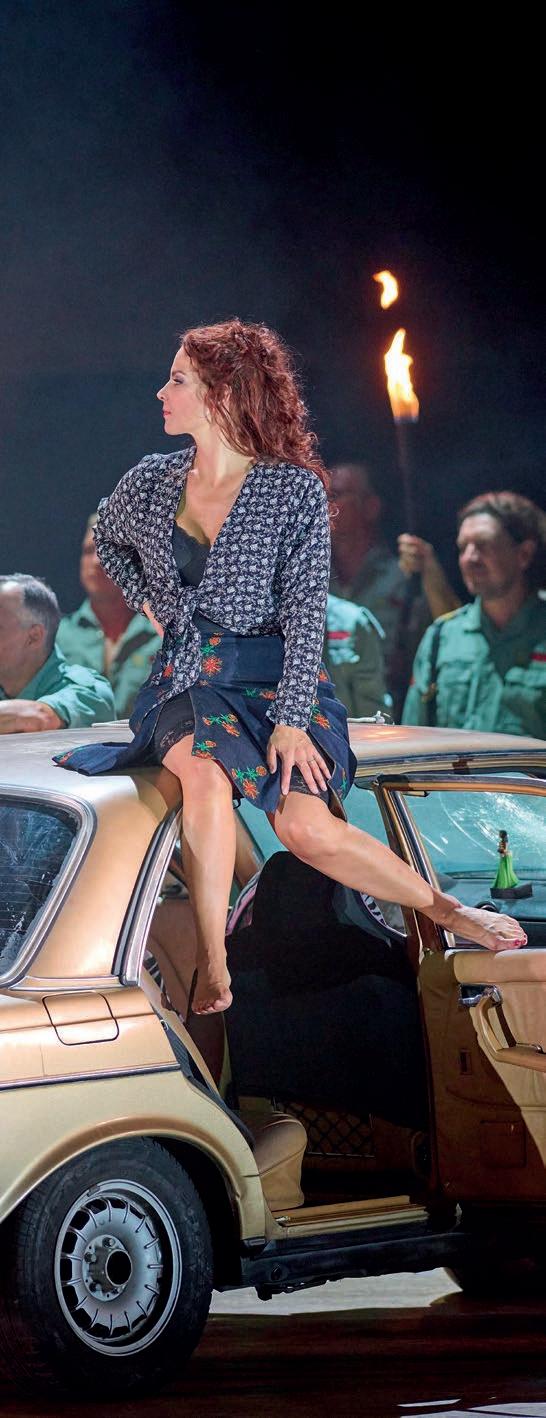
Yet Garanča mentions that there are many things she would like to talk to Carmen about, in particular her past. “Every one of us is a product of who we were before – and when it comes to Carmen, we don’t know anything about that,” she says. With the revival of Aida, State Opera Director Bogdan Roščić has once again offered her a role that showcases her talents. “The role of ‘Amneris’ is my Mount Everest, my pinnacle. After this I can call it quits,” smiles Garanča, who performs alongside Jonas Kaufmann as Radamès.
The artist recently reflected publicly on the parallels between the two roles. “There are a lot of bitches in the soprano repertoire: Carmen, Dalila, Kundry, and many others.” But she also believes that many of Amneris’ reactions have an impulsive nature and are “not particularly calculated at all.” And she notes that it is precisely these facets that interest her most about the role. Garanča has spent two years preparing for it. “Amneris has always been on my bucket list,” she confides.
The role of Kundry in Parsifal and her Wagnerian debut at the Vienna State Opera mark further milestones. “I’ve been on this stage more than 150 times since 2003,” remarks the mezzo-soprano. “Every time I’m up there, I think about how many legendary conductors and singers that house has hosted, and it fills me with great pride. At the State Opera, you can reach for the stars.”
Just recently she became the first woman to receive the Austrian Music Theater Prize’s special media award. She is also very personally committed to promoting young artists and, together with her husband Karel Mark Chichon, works to support young talent with the initiative “ZukunftsStimmen” (Future Voices). Garanča herself was “born into the world of music”; as a vocal professor, her mother ensured that she received the requisite training, and as a conductor, her father was on hand to provide support. n

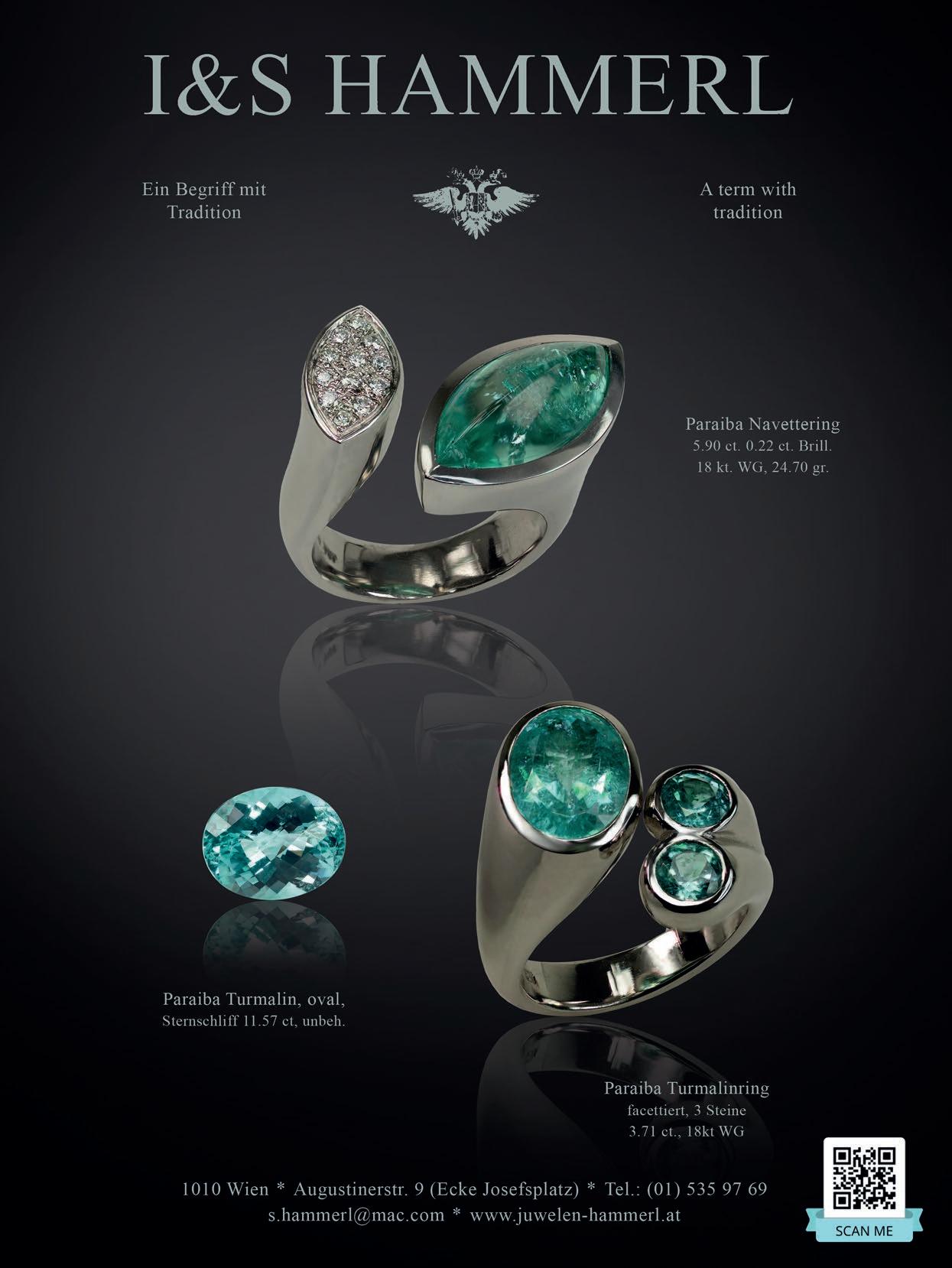
Die „Graf von Faber-Castell Collection“ stellt die Welt des exklusiven Schreibens in den Mittelpunkt: Ein komplettes Portfolio von exklusiven Schreibgeräten, Kassetten und Accessoires ist daraus entstanden.
Graf von Faber-Castell Collection
IM WELTMARKT EXKLUSIVER SCHREIBWAREN HÄLT FABER-CASTELL MIT DIESER AUSRICHTUNG SEIT JAHREN SEINE ALLEINSTELLUNG.
Magnum Edition
Weidler Schreibwaren
Weidler Schreibwaren Graben 26 1010 Wien +43 533 50 10 www.weidler-shop.at
Unverwechselbar wird die Kollektion durch die kontrastierende Kombination von Edelhölzern und -metallen und durch die Kreation einzigartiger Schreibgeräte, die mit der neuen Magnum Edition um eine Serie von höchster Eleganz ergänzt wurde. For ideas that last – die Magnum Edition aus Walnussholz. Mit ihrer dynamischen Silhouette setzt die Magnum Edition optisch ganz neue Akzente. Der Füllfederhalter der Edition ist wie geschaffen für die besonderen Momente, in denen man sich Zeit nimmt, um persönliche Zeilen zu verfassen. Alle Schreibgeräte der Magnum Edition werden in einer eleganten Geschenkverpackung aus Holz überreicht. n


The “Graf von Faber-Castell Collection” showcases the world of exclusive writing. The result − a complete portfolio of premium writing instruments, cartridges, and accessories.
The Graf von Faber-Castell Collection
This approach has secured Faber-Castell its unrivaled position in the global market for exclusive stationery and writing instruments.
The collection is rendered truly distinctive by its contrasting pairing of precious woods and metals, as well as by the creation of unique writing instruments, to which the new Magnum Edition contributes a series of utmost elegance. For ideas that last – the Magnum Edition in walnut. The Magnum Edition adds a fresh visual twist thanks to its dynamic silhouette. The fountain pen of the edition has been created for those special moments when you take the time to write by hand and from the heart. All Magnum Edition writing instruments come packaged in an elegant wooden gift box. n
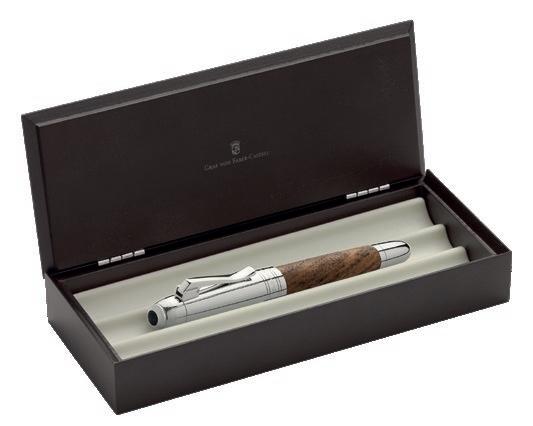

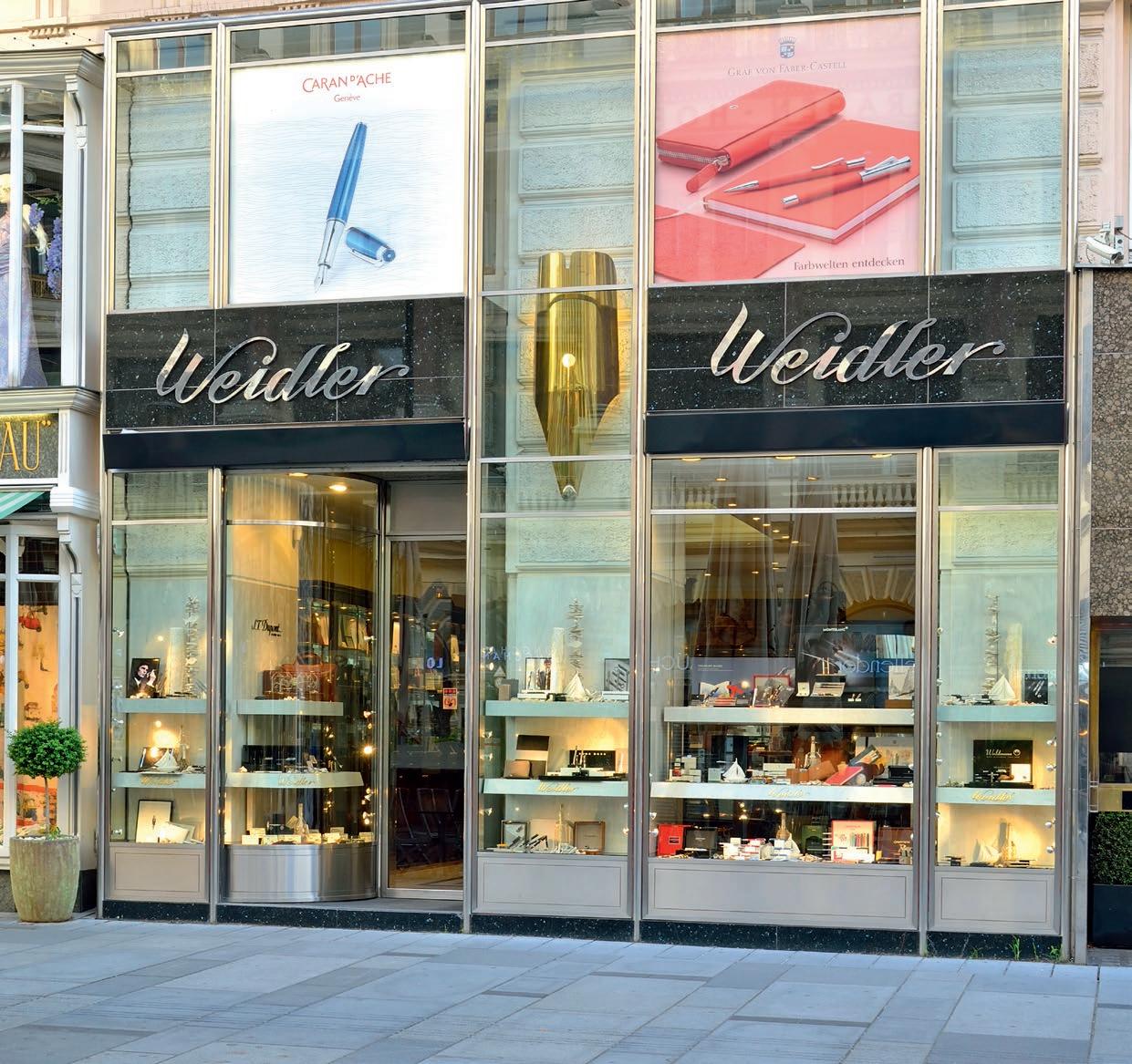






...wenn’s ums schreiben geht The House of Writing Founded 1882 TEL.: 01/533 50 10 FAX: 01/533 89 59 GRABEN 26 1010 WIEN office@weidlerschreibwaren.at www.weidler-shop.at
DIE WIENER STAATSOPER
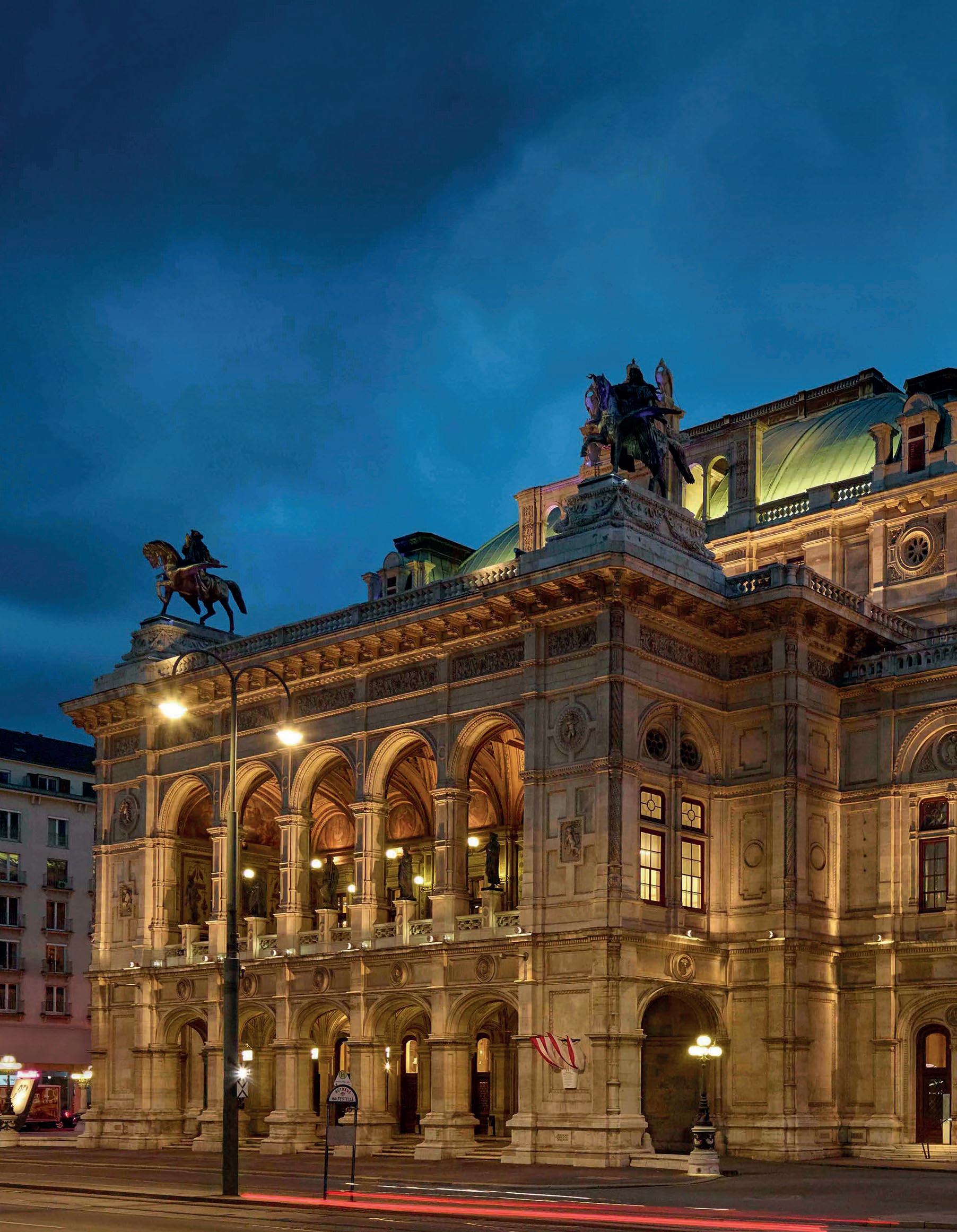
STAATSOPER
"Das Erste Haus am Ring"
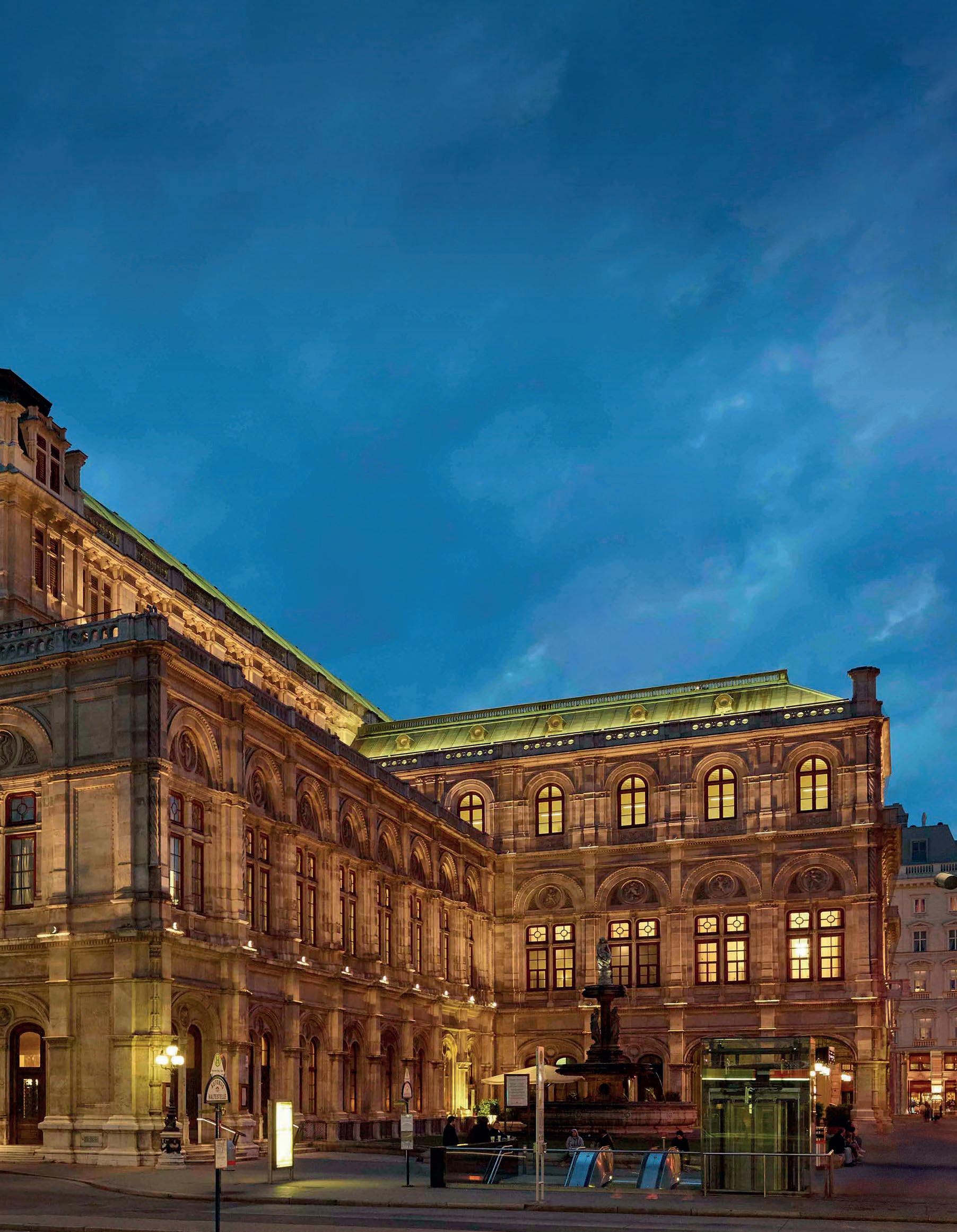 © Michael Pöhn
© Michael Pöhn
NICHT NUR EIN WAHRZEICHEN WIENS, SONDERN EIN STRAHLENDES SYMBOL FÜR DAS KULTURLAND ÖSTERREICH. DIE SPIELZEIT 2022/23 STEHT UNTER EINEM BESONDEREN MOTTO, WARTET MIT TOP-PRODUKTIONEN AUF UND ZU SAISONBEGINN GAB ES JUBEL UND PROTESTE.
Im ersten Bezirk ist die glanzvolle Geschichte Wiens zu spüren, überall liegt die imperiale Vergangenheit in der Luft. Unbestritten eines der imposantesten Gebäude ist die Wiener Staatsoper, die nicht ohne Grund auch "Das Erste Haus am Ring" genannt wird. Das nach Plänen im Stil der Neorenaissance von August Sicard von Sicardsburg und Eduard van der Nüll errichtete Gebäude wurde 1869 mit „Don Juan“ von Mozart eröffnet und konnte sich als weltweit führendes Opernhaus etablieren. Vor 125 Jahren wurde Gustav Mahler als Direktor in das „Erste Haus am Ring“ berufen.
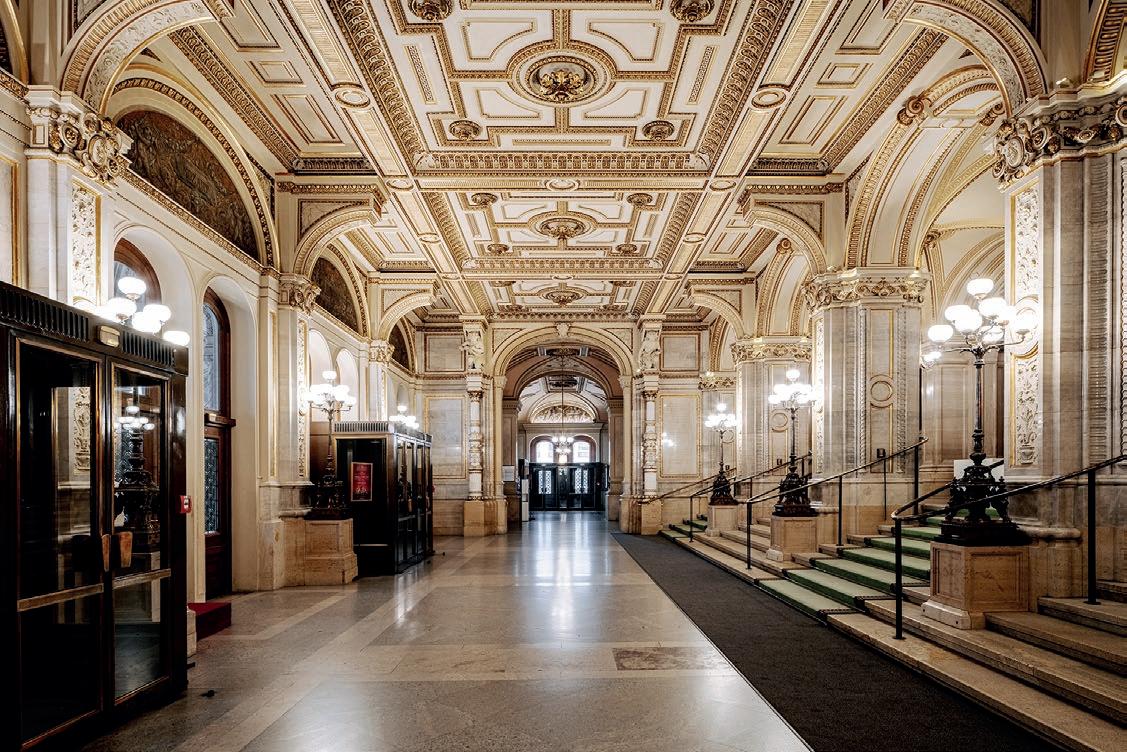
In der aktuellen Saison sollen alle Neuproduktionen eine direkte Verbindung zum Komponisten haben und die aktuelle Weltlage auf eigene Art widerspiegeln. Für den Auftakt sorgt ein
spezielles Mahler-Projekt: Obwohl zehn Jahre Direktor, Dirigent von mehr als 100 Opernabenden und Schreiber von neun vollendeten Sinfonien unterließ es der begnadete Komponist, eine eigene Oper zu schaffen.
Im Jubiläumsjahr stellt sich die Staatsoper die Aufgabe, zwei seiner Werke zu einer Oper zusammenzufassen. Die berühmte Kantate „Das klagende Lied“ wird mit dem tragischen Lie -
© Wien Tourismus Paul Bauer

derzyklus „Kindertotenlieder“ zur Neuproduktion „Von der Liebe Tod“ verbunden. Das Programm nimmt zum aktuellen Weltgeschehen Stellung: "Es dreht sich um den Kampf des Menschen gegen sich selbst in all den Ausprägungen, zu dem nur unsere Spezies imstande ist", sagt Staatsopern-Direktor Bogdan Roščić Die angespannte Situation wurde schon zum Auftakt deutlich: Denn Anna Netrebko hat sich nach einer „sanktionsbedingten“ Auftrittspause mit der Bohème - welche wegen krankheitsbedingter Absagen bei "La Juive" angesetzt wurde - zurückgemeldet und erntete dafür Lob, aber auch lautstarke Proteste. Viel Zuspruch gibt es hingegen für Elina Garanca in der „Carmen“.
Am Programm stehen die von Keith Warner neuinszenierten Wagnerischen „Die Meistersinger von Nürnberg" und „Salome“ von Richard Strauss. Premiere am Haus feiert Malin Byström sowie auch „Le Nozze di Figaro“ dirigiert von Musikdirektor Philippe Jordan. Mit der Premiere „Il ritorno d’Ulisse in patria“ schließt sich der Monteverdi-Zyklus. „Dialogues des Carmélites“ von Francis Poulenc bringt mit Sabine Devieilihe als Blanche, Nicole Car als Madame Lidoine und Eve-Maud Hubeaux als Mère Marie internationale Rollendebüts.

Für die 48 Opern und acht Ballettstücke stehen 330 Mitglieder des Orchesters, der Bühnenmu-
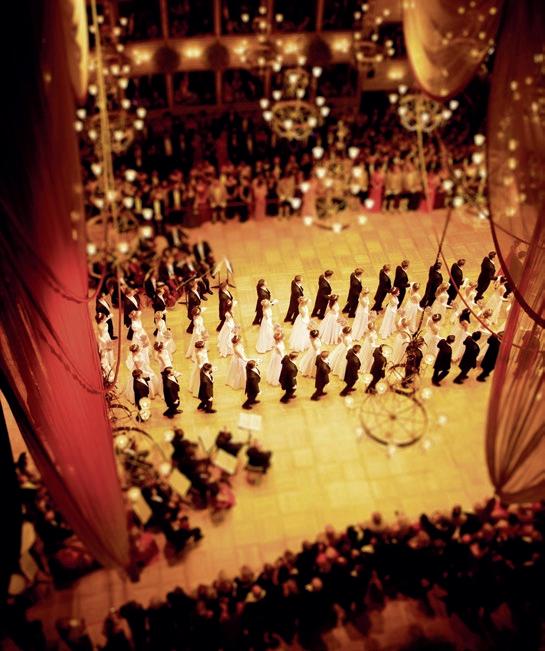
sik, des Chors und des Balletts bereit. Ihnen zu Ehren verwandelt sich die Oper für eine Nacht in den schönsten Ballsaal der Welt und alles dreht sich im 3/4-Takt unter dem drei Tonnen schweren Kristallluster. n n

© Monika Rittershaus
© Wiener Staatsoper
© Michael Poehn
The Vienna State Opera
NOT MERELY A LANDMARK OF VIENNA, BUT A RESPLENDENT SYMBOL OF AUSTRIA AS A LAND OF CULTURE. THE 2022/23 SEASON HAS A SPECIAL MOTTO, FEATURING FIRST-CLASS PRODUCTIONS AND PROMPTING CHEERS AND PROTESTS AS THE SEASON OPENED.

”The first house on the Ring”
Vienna’s glorious history is palpable in the first district; its imperial past permeates the air. Without a doubt, one of the most impressive buildings is the Vienna State Opera, nicknamed the “first house on the Ring” for good reason. Built according to plans by August Sicard von Sicardsburg and Eduard van der Nüll in neo-Renaissance style, the building was inaugurated in 1869 with Mozart’s Don Juan and went on to become the world’s leading opera house.
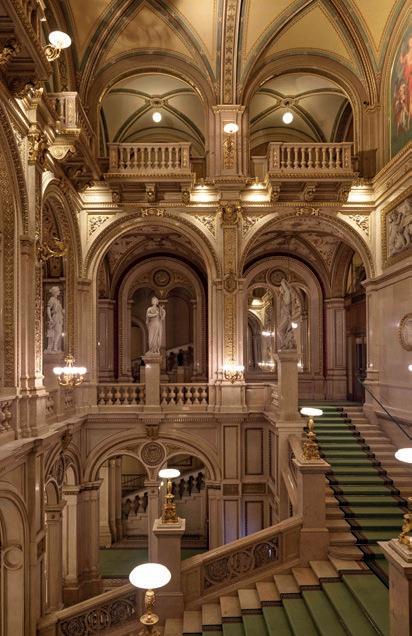
It was 125 years ago that Gustav Mahler was appointed director of the “first house on the Ring.” All new productions in the current season are meant to bear a direct connection to the composer, and to reflect the current world situation in their own way. A very special Mahler project will kick things off: Although he served as director for ten years, conducted more than 100 opera recitals, and wrote nine finished symphonies, the gifted composer failed to compose an opera of his own.

In this anniversary year, the State Opera has embarked on the challenge of combining two of his works to create a single opera. The famous cantata “Das klagende Lied” (Song of Lamentation) is combined with the tragic song cycle “Kindertotenlieder” (Songs on the Death of Children) to create the new production Von der Liebe Tod. The opera takes a stand on current world events. “It’s all about man’s struggle against himself, in all the
manifestations of which only our species is capable,” explains Bogdan Roščić, Director of the State Opera.
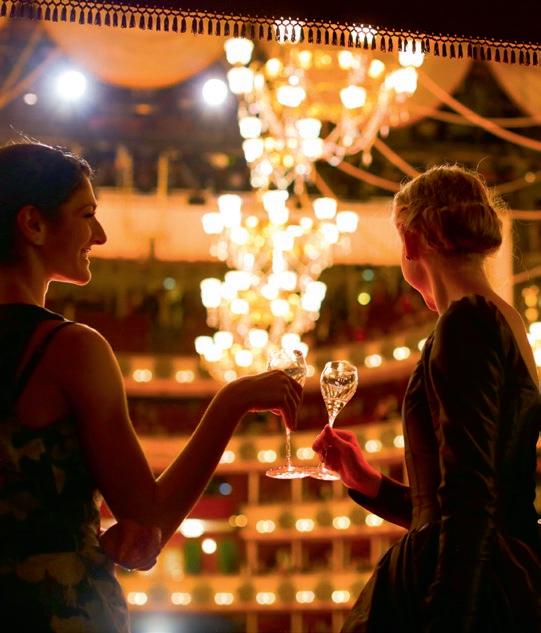
The tension was evident from the outset. Anna Netrebko returned after a “sanction-related” interruption of her performance of Bohème – which was scheduled due to cancellations of La Juive due to illness – and garnered both praise and vociferous protests. In contrast, there was considerable praise for Elina Garanca in Carmen. The program includes the Wagnerian Die Meistersinger von Nürnberg and Salome by Richard Strauss, both of which have been restaged by Keith Warner. Malin Byström celebrates her premiere at the opera house together with Le Nozze di Figaro conducted by music director Philippe Jordan.
The premiere of Il ritorno d’Ulisse in patria concludes the Monteverdi cycle. Dialogues des Carmélites by Francis Poulenc features international role debuts with Sabine Devieilihe as Blanche, Nicole Car as Madame Lidoine, and Eve-Maud Hubeaux as Mère Marie. A total of 330 members of the orchestra, incidental music, chorus, and ballet are on hand for the 48 operas and eight ballets. In their honor, the Vienna State Opera is transformed every year for one night into the most beautiful ballroom in the world, and everything moves in 3/4 time under the three-ton crystal chandelier.
n
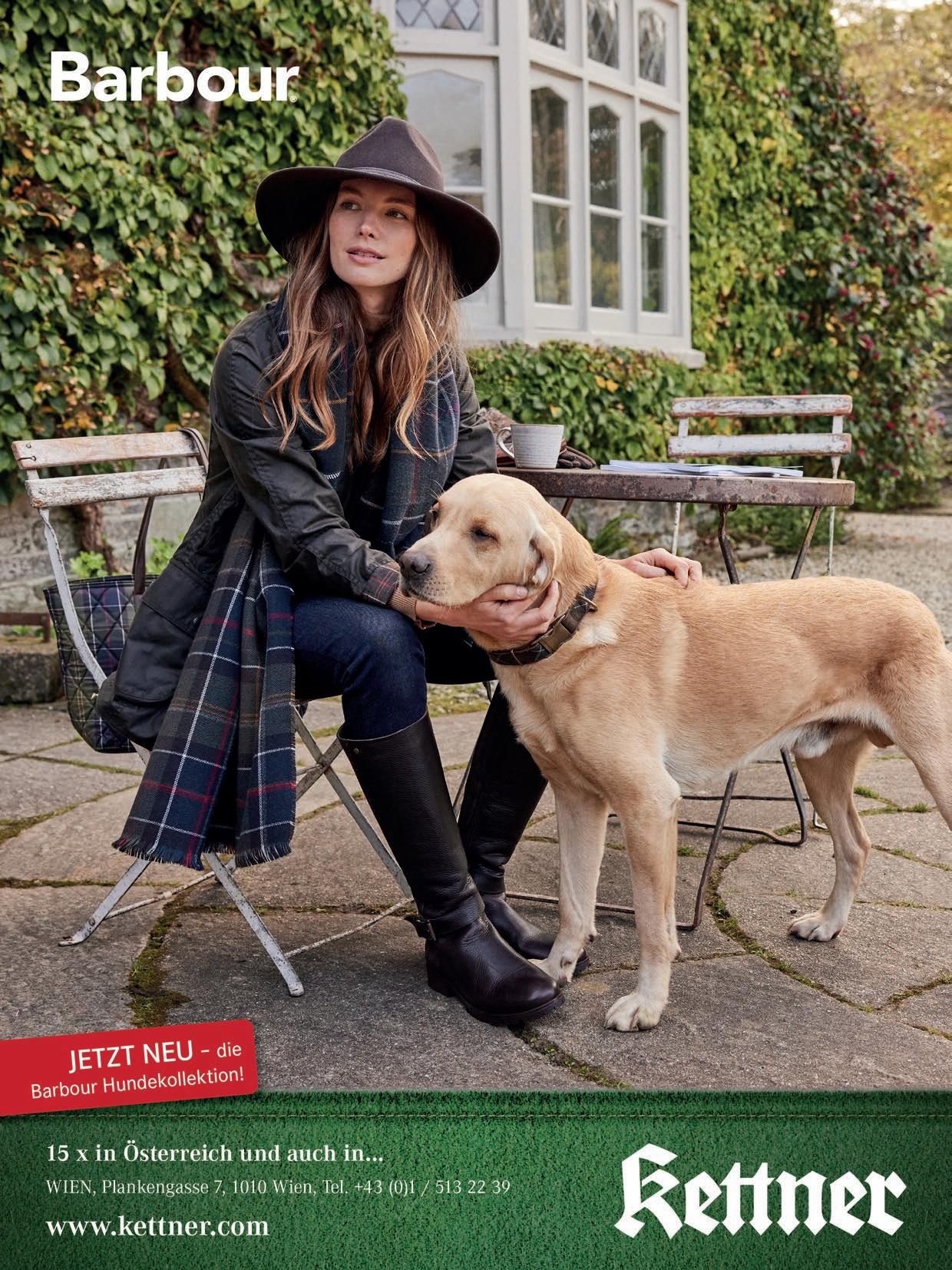
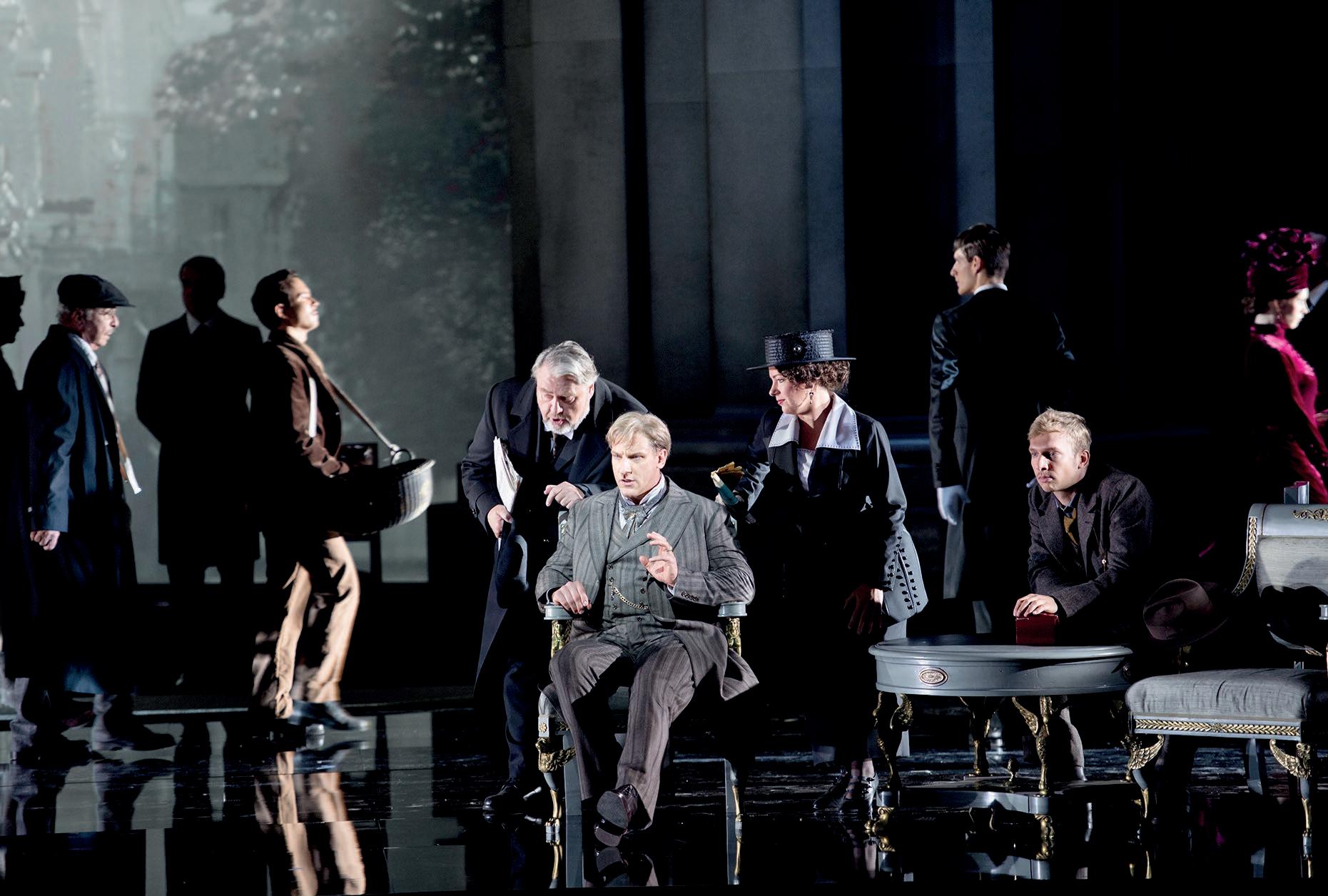 © Salzburger Festspiele Monika Rittershaus2
© Salzburger Festspiele Monika Rittershaus2
EIN NIEDERÖSTERREICHER MIT EDLEM STIMMKLANG, ATEMBERAUBENDER AUSDRUCKSKRAFT UND EINEM HANG ZUM WIENERISCHEN BEGEISTERT AN DEN FÜHRENDEN OPERNHÄUSERN DER WELT. IN DER AKTUELLEN SAISON IST GÜNTHER GROISSBÖCK ERNEUT ALS „SARASTRO“ IM EINSATZ UND ÜBERRASCHT MIT RAUEREM TIMBRE.
„Sarastro“ überrascht er in rauerem Timbre
Günther Groissböck
Wenn man an Waidhofen in Niederösterreich denkt, verbindet man dies auf den ersten Blick nicht mit einem Opernstar von internationalem Format. Doch dem an der Ybbs geborenen Günther Groissböck ist eine große Karriere gelungen.

Der heute 46-Jährige studierte Gesang an der Universität für Musik und darstellende Kunst in Wien und holte sich bei Berühmtheiten wie Robert Holl und José van Dam sein gediegenes Rüstzeug. Schon sein Debüt als einer der vier Könige in Strauss' „Die Liebe der Danae“ bei den Salzburger Festspielen brachte ihm hohe Aufmerksamkeit und er wurde bald in das Ensemble der Wiener Staatsoper aufgenommen, wo er als Luther in Offenbachs „Les Contes d'Hoffmann“ erstmals auf diesen berühmten Brettern stand. Auch als „zweiter Maat“ in „Billy Bud“, zweiter „Geharnischter“ in der „Zauberflöte“ und zweiter Gralsritter im „Parsifal“machte er eine gute Figur. „Wassermann“, König Heinrich in „Lohengrin“ und „Rocco“ in „Fidelio“ zählten hier zu seinen Rollen.
Ein ganz besonderes Erlebnis war schon sein Rollendebüt als „Ochs auf Lerchenau“ im „Rosenkavalier“ bei den Salzburger Festspielen 2014. "Ich wurde schon länger bearbeitet, diese Partie zu singen, vor allem vom ehemaligen Wiener Staatsoperndirektor Ioan Holender", verrät der Niederösterreicher, der damals aber noch Probleme mit dieser Figur hatte. Zu wenig kantig sei diese. "Der Ochs wird ja meistens als harmloser Onkel dargestellt“, meinte er damals. Sein Ochs wurde schließlich umjubelt und Groissböck als neuer „Idealtyp“ für diese diffizile Rolle gefeiert. Er brillierte damit neben der Wiener Staatsoper, auch an der Met, in München und in Berlin.
Auch in der „Zauberflöte“ kann er seine Begabungen voll zur Geltung bringen, „Sarastro“ gilt als seine Paraderolle. In der aktuellen Saison präsentiert sich seine Stimme dabei rauer als
man es von ihm sonst gewohnt ist, aber mit allen Höhen und Tiefen, die ein „Sarastro“ brauche, loben die Kenner.
Als erfolgreicher Konzertsänger bereiste er die Welt von seinem Wohnsitz im Tressin aus und widmet sich auch dem Liedgesang - er hat beispielsweisemit Gerold Huber eine Schubert-Doppel CD eingespielt -, gab sein Regiedebüt mit Tristan und Isolde am Theater an der Wien, wo er auch den König Marke sang und hat ein Faible für das Wiener Lied. Gemeinsam mit Tenor Karl-Michael Ebner blickt er in Duetten wie „Der Weana geht ned unter“ zurück in die zweite Hälfte des 19. Jahrhunderts, „Mir ist es wichtig, dass mein Beruf nie zur Routine wird“, so Groissböck, der zu den international gefragtesten Bässen seiner Generation zählt. . n
© Dominik Stixenberger
Als
A LOWER AUSTRIAN WITH A REFINED VOCAL TIMBRE, BREATHTAKING EXPRESSIVENESS, AND A PENCHANT FOR THE VIENNESE, GROISSBÖCK CONTINUES TO DELIGHT AUDIENCES AT THE WORLD’S LEADING OPERA HOUSES. IN THE CURRENT SEASON, GÜNTHER GROISSBÖCK IS BACK IN ACTION AS "SARASTRO," BOASTING A SURPRISINGLY RAWER TIMBRE.
GÜNTHER GROISSBÖCK
When people think of Waidhofen in Lower Austria, they don’t initially associate the town with an internationally renowned opera star. Yet Günther Groissböck, a native of the region and born on the Ybbs, has succeeded in forging a distinguished career for himself. The 46-year-old studied vocal performance at the University of Music and Performing Arts Vienna and learned his craft from celebrities such as Robert Holl and José van Dam. His debut as one of the four kings in Strauss’ Die Liebe der Danae (The Love of Danae) at the Salzburg Festival had already attracted a great deal of attention, and he was soon accepted into the ensemble of the Vienna State Opera, where he first appeared on that celebrat-
ed stage as Luther in Offenbach’s Les Contes d’Hoffmann (The Tales of Hoffmann). He also performed impressively as the “second mate” in Billy Bud, the second “man in armor” in The Magic Flute and the second Knight of the Grail in Parsifal. His roles also included “Wassermann,” King Heinrich in Lohengrin, and “Rocco” in Fidelio.
His role debut as “Baron Ochs von Lerchenau” in Rosenkavalier at the 2014 Salzburg Festival was a truly remarkable event. “I had been approached to perform that part for quite some time, especially by former Vienna State Opera director Ioan Holender,” reveals the Lower Austrian, who at that time, however, still had some issues with the
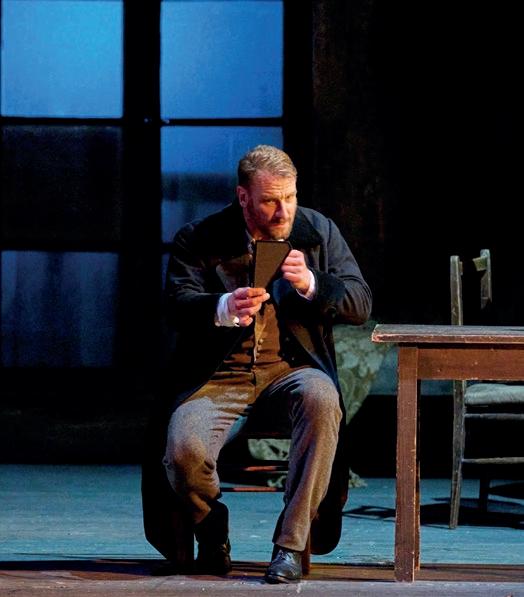
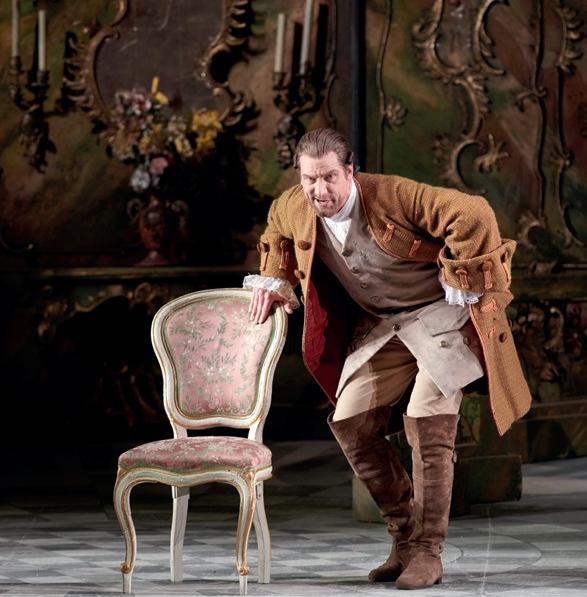
Surprising audiences with a raw timbre in the role of “Sarastro”
character. He felt that it just wasn’t edgy enough. “After all, Baron Ochs is usually portrayed as a harmless uncle,” he said at the time. His performance of the role was ultimately highly acclaimed, and Groissböck was hailed as the new “ideal” for this difficult role. In addition to performances at the Vienna State Opera, he has also dazzled audiences at the Met, in Munich, and in Berlin. The Magic Flute provides him with the perfect showcase for his artistic prowess, and “Sarastro” is considered to be his signature role. In the current season, his voice is rawer than audiences are used to, but experts agree that it features all the highs and lows that a “Sarastro” demands. From his home in Tressin he has traveled the world as a renowned concert
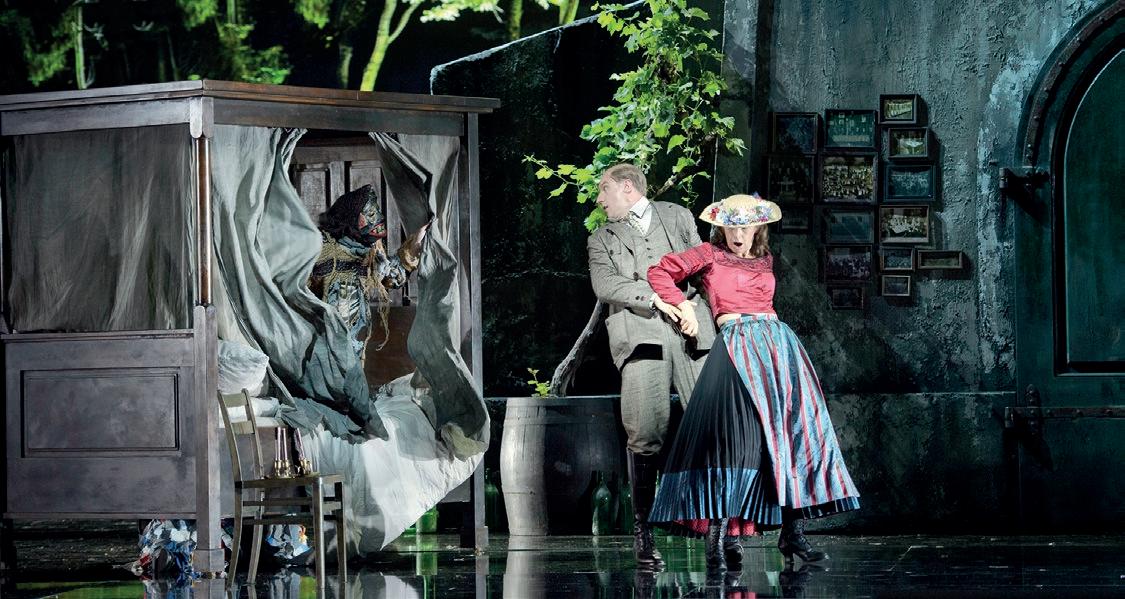
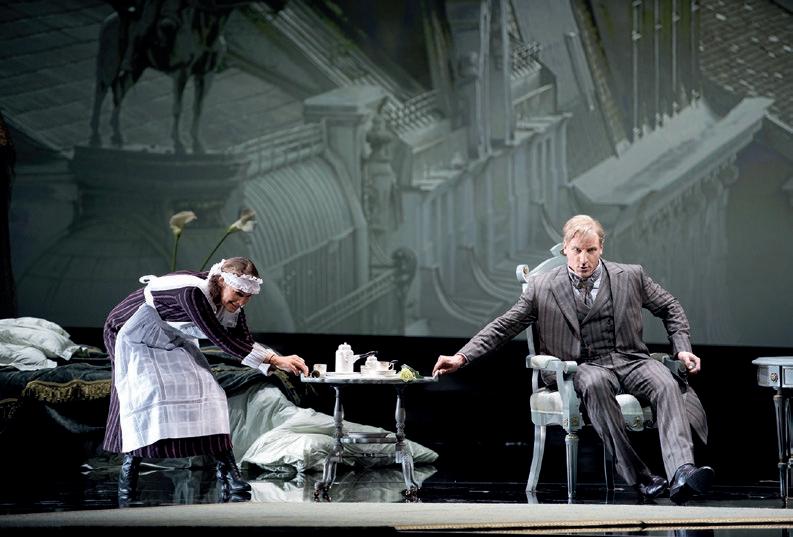
singer and also specializes in the performance of lieder – recording a Schubert double CD with Gerold Huber – as well as giving his directorial debut with Tristan und Isolde at the Theater an der Wien, where he also sang the role of Marke, King of Cornwall. Together with tenor Karl-Michael Ebner, he takes a retrospective look at the second half of the 19th century in duets that include “Der Weana geht ned unter.”

“To me, the important thing is for my profession never to become routine,” notes Groissböck, who ranks among the most internationally acclaimed bass voices of his generation.
n
© Monika Rittershaus
© Monika
Rittershaus
Das Traditionshaus am Wiener Graben und ehemaliger k.u.k. Parfumeur gilt als eine der ersten Adressen für feinste Düfte und Kosmetik aus eigener Manufaktur - Tradition und Moderne
• J.B.Filz Eau de Lavande
1892 schrieb Wilhelm Filz zu seiner Rezeptur für Lavendelwasser „alle anderen streichen“
• J.B.Filz Wiener Lieblingsduft
Nach Napoleon und Wiener Kongress kreiert 1830 Johann Baptist Filz den Duft, der Walzer und Dreivierteltakt atmet.
• J.B.Filz Imperiales Veilchen
Den von Wilhelm Filz komponierten Duft hat schon bald Kaiserin Sissi ins Herz geschlossen.
• J.B.Filz Café de Vienne
Die Inspiration, Kaffeeduft als Eau de Parfum anzubieten, wurde 2018 realisiert. Eine Erinnerung an Wiens Kaffeetradition.
• J.B.Filz Café Esprit
Eau de Toilette ist die leichtere Variante für Kaffeeliebhaber aller Altersstufen.
The first perfumerie on The Graben (Grabenno.13)

J. B. Filz Sohn
It was in the year 1809 – Archduke Karl had just defeated Napoleon at Aspern – when Anton Filz set up the first perfumery on The Graben. Creams, soaps, pomades and scents were created and prepared by him.
In 1815 Vienna became for some month the focal point for European society : the Congress of Vienna met to establish Europe's new frontiers and danced for joy at the ending of Napoleon´s military might. The „Perfume Vaults“ on The Graben soon became the meeting place for the elegant world. Filz travelled by postal-mail-coach to London and Paris to procure exclusive foreign products for his demanding clients. And in 1872 the firm was appointed Court Perfumer. Since then the scent of the big wide world has been at home at Filz on The Graben. n
instagram: parfumerie_filz • facebook: parfumerie.jb.filz
House of tradition at Graben in Vienna, former supplier to the Imperial Court, one of the first addresses for fine fragrances and cosmetics exclusively manufactured traditonal and modern.
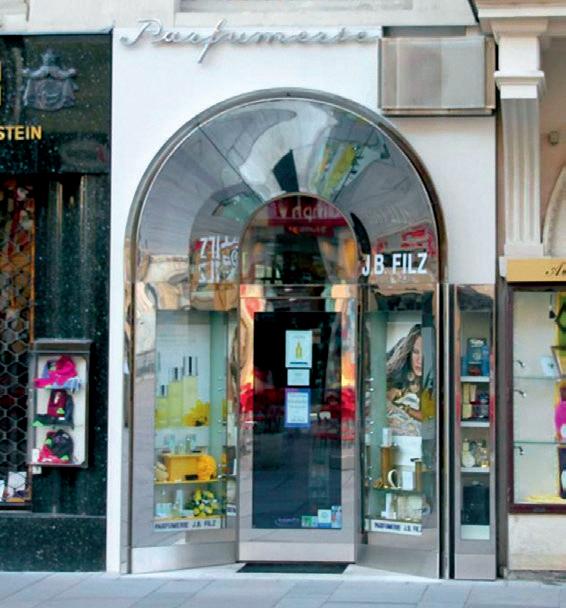
• J.B.Filz Eau de Lavande 1892 Wilhelm Filz noted to his receipe „all others to be deleted“.
• J.B.Filz Viennese Darling´s Fragrance Fragrance of 1830 by Johann Baptist Filz to commemorate the Viennese Waltz after Napoleon and the Congress of Vienna.
• J.B.Filz Imperial Violet Composed in 1850 by Wilhelm Filz. It soon made empress Sissi to fall in love with this fragrance.
• J.B.Filz Café de Vienne
The idea to offer coffee fragrance as an Eau de Parfum was realized in 2018 to remember the Viennese coffee tradition.
• J.B.Filz Café Esprit
Eau de Toilette is the lighter variation for lovers of coffee of all ages.
J. B. FILZ SOHN


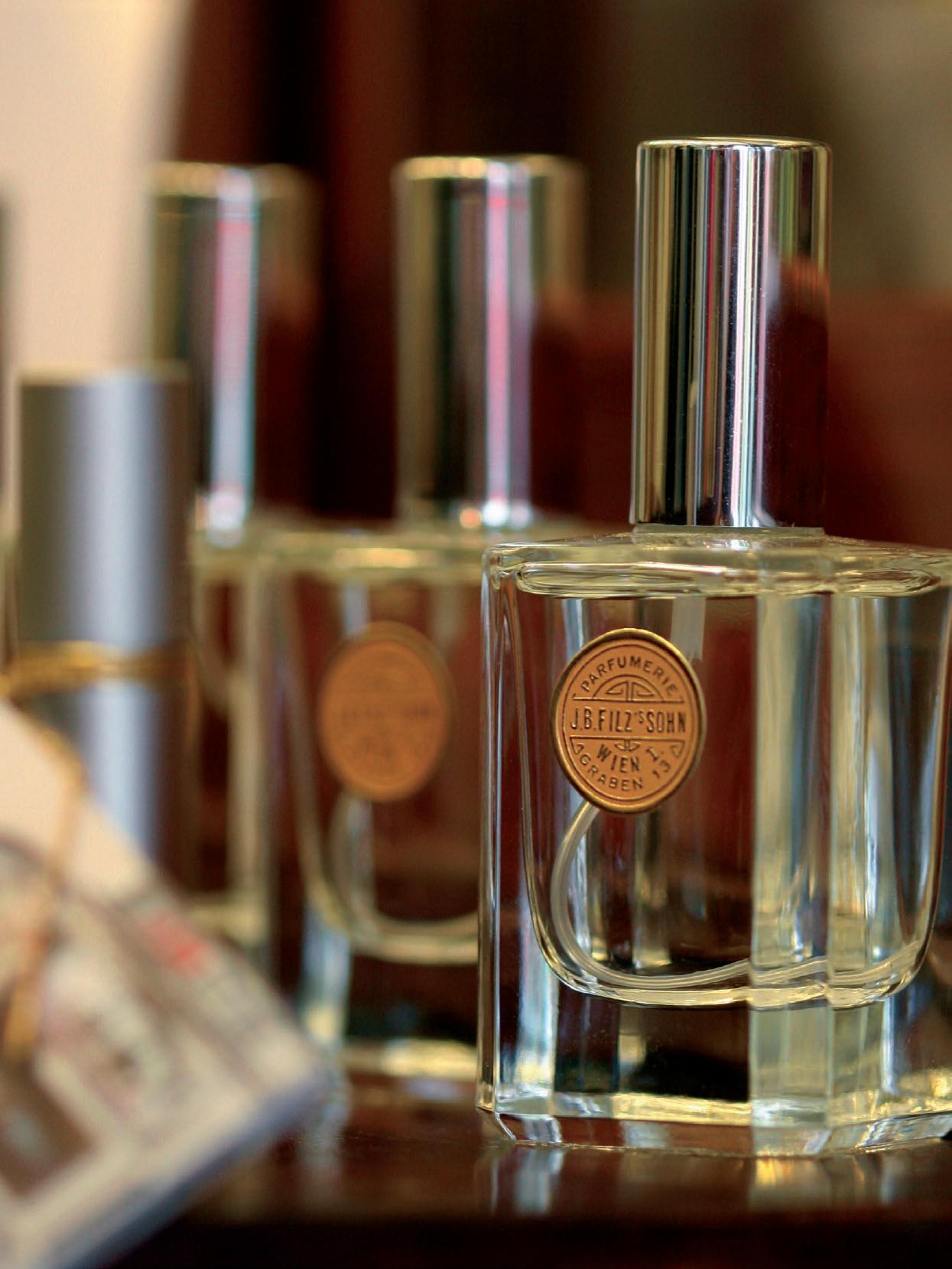
Seit 1954 klassische Friseurdienstleistungen auf höchstem Niveau
DER MENSCH MIT SEINEN ANSPRUCHSVOLLEN BEDÜRFNISSEN NACH HOCHWERTIGER HAARPFLEGE, SCHÖNHEIT UND WOHLBEFINDEN STEHT IN UNSEREM SALON DIREKT IM HERZEN VON WIEN HINTER DEM STEPHANSDOM AN OBERSTER STELLE.
Viel Gefühl und Leidenschaft für den Beruf und die Menschen prägt unser in dritter Generation geführtes Familienunternehmen. Ein Ort, an dem man sich so richtig wohlfühlen darf, loslassen und entspannen kann. Wir bieten Ihnen klassische Friseurdienstleistungen auf höchstem Niveau und ausgeführt mit modernsten Techniken. Unser Hauptanliegen bei der Durchführung all dieser Dienstleistungen ist die schonendste Vorgehensweise und die gezielte Regeneration und Gesund-
Frisör OSSIG
Frisör OSSIG
Stephansplatz 4 1010 Wien +43 1 512 43 67 www.ossig.at
erhaltung der Kopfhaut und deren Funktionen. Denn nur aus gesunder Kopfhaut wächst gesundes Haar. Als perfekte Ergänzung zu Ihrem individuellen Friseurerlebnis bieten wir Ihnen Kosmetik- und Wellness-Goodies, die Ihnen im Salon das Gefühl eines wohltuenden und entspannten Kurzurlaubs vermitteln. Seit 1954 verbinden wir professionelle Beratung & Handwerk auf höchstem Niveau, weil Ihre Schönheit und Ihr Wohlbefinden für uns wirklich Herzenssache sind. n

State-of-the-art traditional hairstyling services since 1954
Situated just behind St. Stephen’s Cathedral in the very heart of Vienna, our salon puts the person and his or her discerning demands for premium hair care, beauty, and well-being in the center of everything we do.


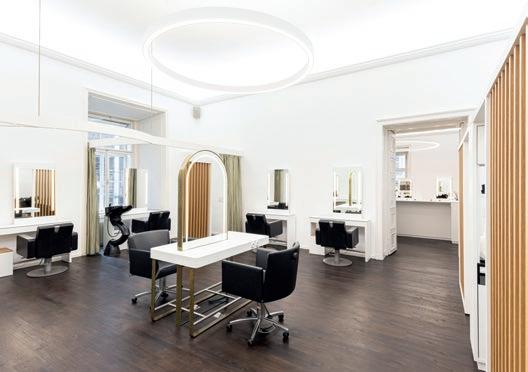

Our family business, now in its third generation, has been shaped by a strong sense of commitment and passion both for the profession and for other people. A place where guests can really feel at home, let go, and relax. We offer traditional hairstyling services of the utmost quality, realized with the most cutting-edge techniques. Our prime concern in providing any of these services is to use the mildest possible approach while focusing on regenerating and maintaining the
health of the scalp and its functions. Because healthy hair can only grow from a healthy scalp. To complement your personalized hairdressing experience to perfection, we offer cosmetic and wellness treats that will leave you feeling like you’re on a blissful and relaxing getaway in the salon. We have been uniting professional guidance with the highest level of craftsmanship since 1954, because to us, your beauty and well-being are truly matters of the heart. n
© André Walther

DAS K UNSTHISTORISCHE MUSEUM




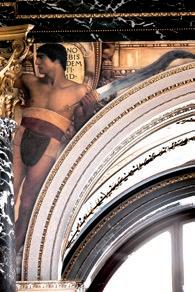
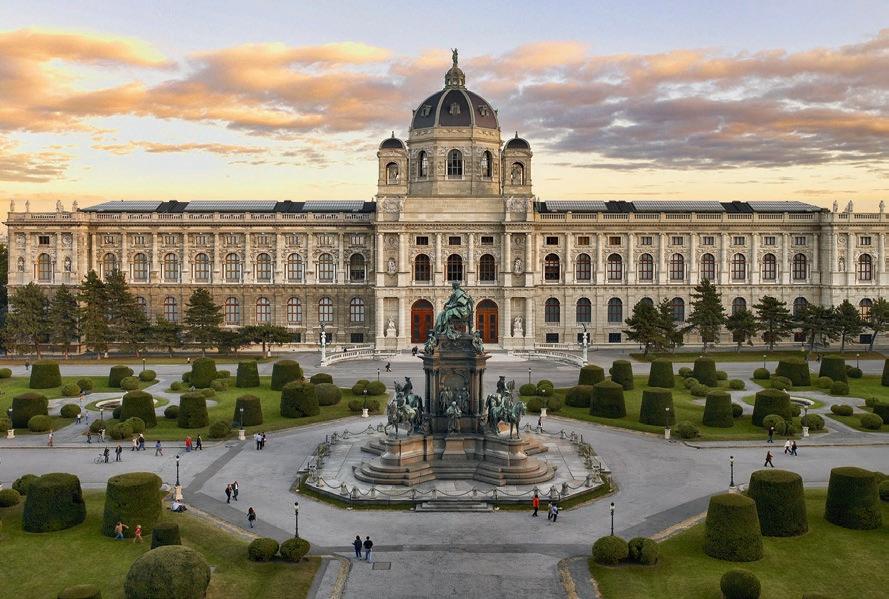
DER GROSSEN SAMMELLEIDENSCHAFT DER HABSBURGER HAT WIEN EINE BESONDERE SCHATZKAMMER MIT UNSCHÄTZBAREN OBJEKTEN ZU VERDANKEN
Die Kunst ist das Höchste und das Widerwärtigste gleichzeitig“, dachte sich der Musikkritiker Reger, Protagonist in Thomas Bernhards Roman „Alte Meister“ (1985), auf einer Bank im Kunsthistorischen Museum sitzend. Ein unvergessliches Erlebnis in allen Facetten von den Pharaonen bis in die Neuzeit ist ein Besuch im Kunsthistorischen auf jeden Fall.
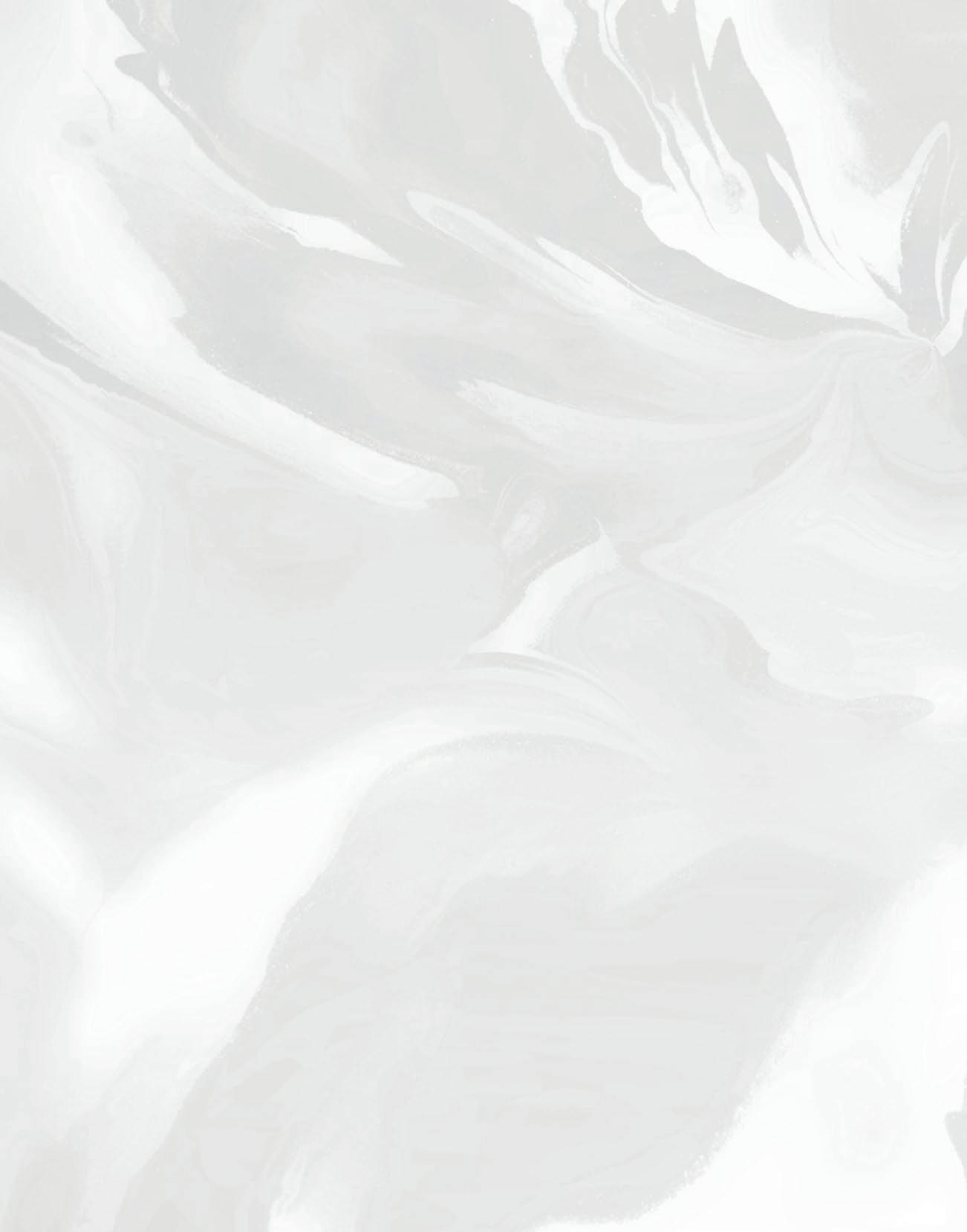
Schon von Außen offenbaren sich die Dimensionen, die in ihm stecken. Mit seinem Schwestergebäude, dem gegenüberliegenden Naturhistorischen Museum, gehört der Prachtbau zu
den bedeutendsten historistischen Großgebäuden der Ringstraßenzeit. Zusammen umrahmen sie das Maria-TheresienDenkmal und bilden ein Ensembledenkmal, das auch zum Weltkulturerbe „Historisches Zentrum von Wien“ gehört.
Schon beim Betreten des von den Habsburgern beauftragten und von den berühmten Architekten Gottfried Semper und Carl von Hasenauer im Stil der italienischen Renaissance erbauten „Palast der schönen Künste“ (1891) wird man in seinen Bann gezogen. In prachtvoller Kulisse werden einzigartige Hauptwerke von Dürer, Raffael, Tizian und Velázquez
sowie die weltweit größte Bruegel-Sammlung präsentiert. Zum 450. Todestag des niederländischen Meisters, von dem nur knapp über 40 Gemälde erhalten sind, von denen das KHM mit zwölf Tafeln die größte Sammlung besitzt, ehrt das KHM das einzigartige Werk des Künstlers mit der weltweit ersten großen monografischen Ausstellung.
Die Ägyptisch-Orientalische Sammlung zählt zu den bedeutendsten Sammlungen ägyptischer Altertümer der Welt und umfasst mehr als 17.000 Objekte aus einem Zeitraum von fast 4500 Jahren. Die rund 2.500 Objekte der Antikensamm -

„MAN KÖNNTE TAGE DARIN VERBRINGEN“, SO GROSS, VIELFÄLTIG UND SPANNEND
IST DIE SAMMLUNG VON OBJEKTEN AUS DEM ALTEN ÄGYPTEN, DER ANTIKE, DEM MITTELALTER UND DER NEUZEIT, PRACHTVOLLEN SKULPTUREN UND SAGENHAFTEN WERKEN DER GRÖSSTEN KÜNSTLER DER WELTGESCHICHTE.
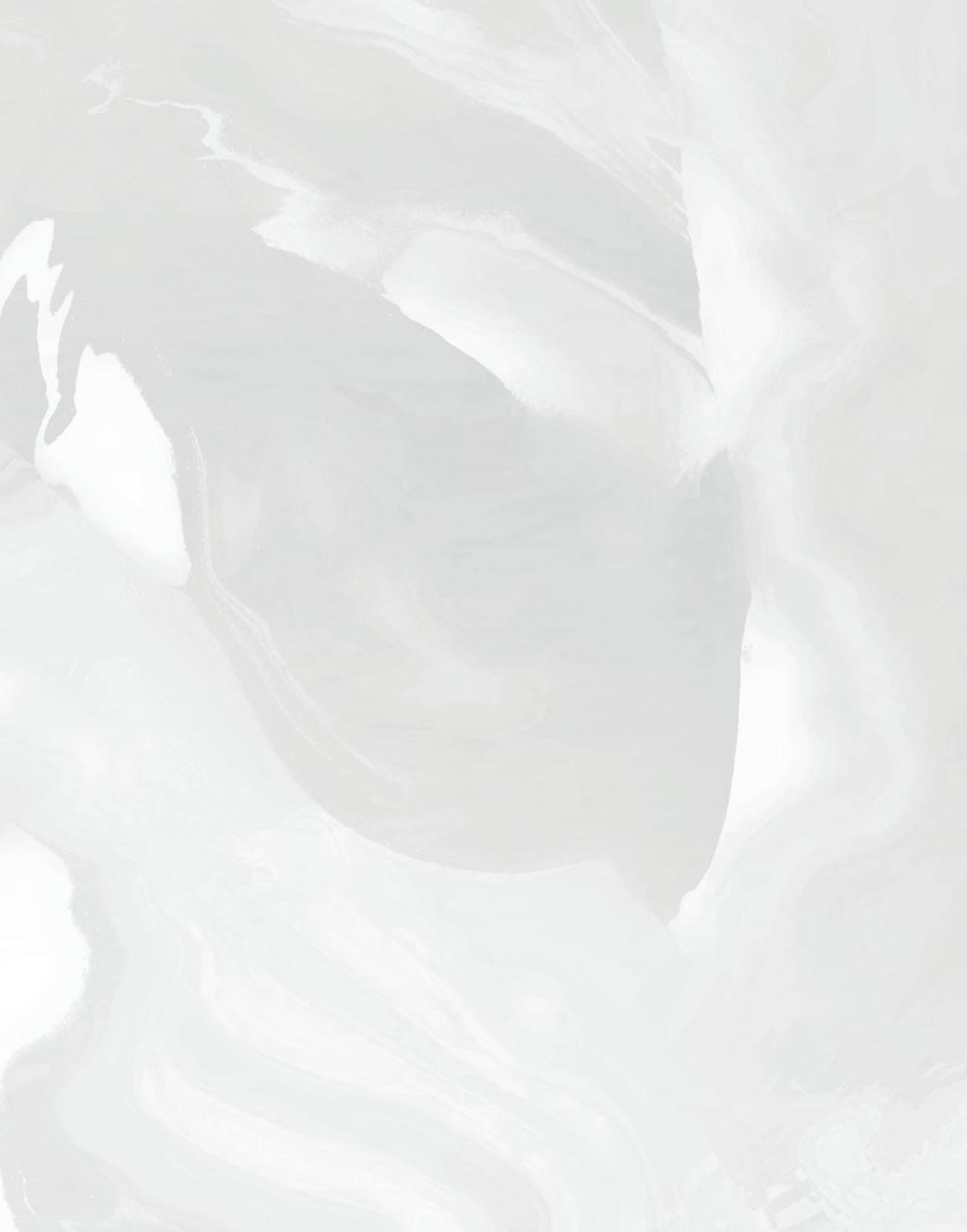
lung aus mehr als drei Jahrtausenden reichen von der bronzezeitlichen Keramik Zyperns aus dem 3. Jahrtausend v. Chr. bis hin zu frühmittelalterlichen Funden.
Mit der venezianischen Malerei des 16. Jahrhunderts (Tizian, Veronese, Tintoretto) über die altniederländischen Meister (Jan van Eyck, Rogier van der Weyden) und die Werke von Vermeer, Rembrandt, Raffael, Caravaggio, Velázquez und der italienischen Barockmalerei kann sich die Gemäldegalerie als eine der größten und bedeutendsten ihrer Art positionieren.

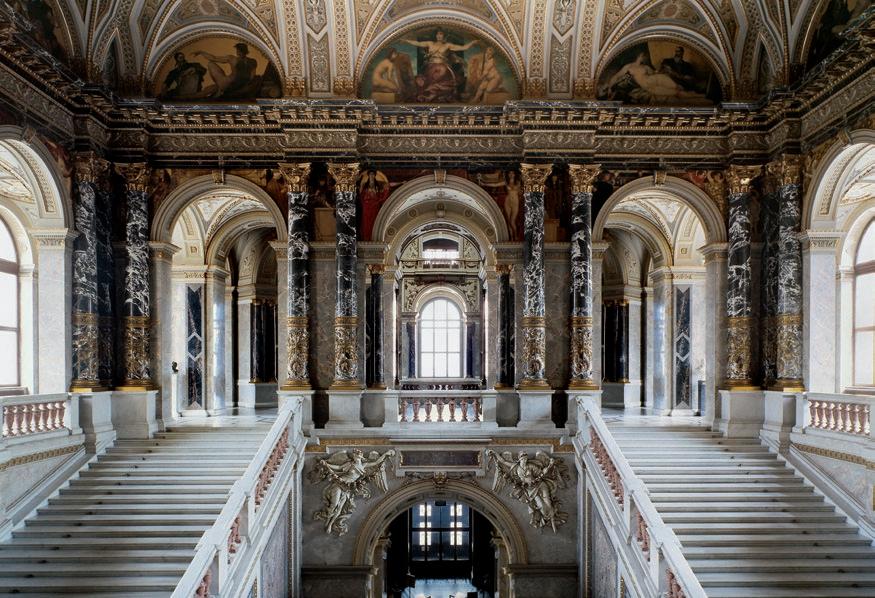
KHM-Museumsverband
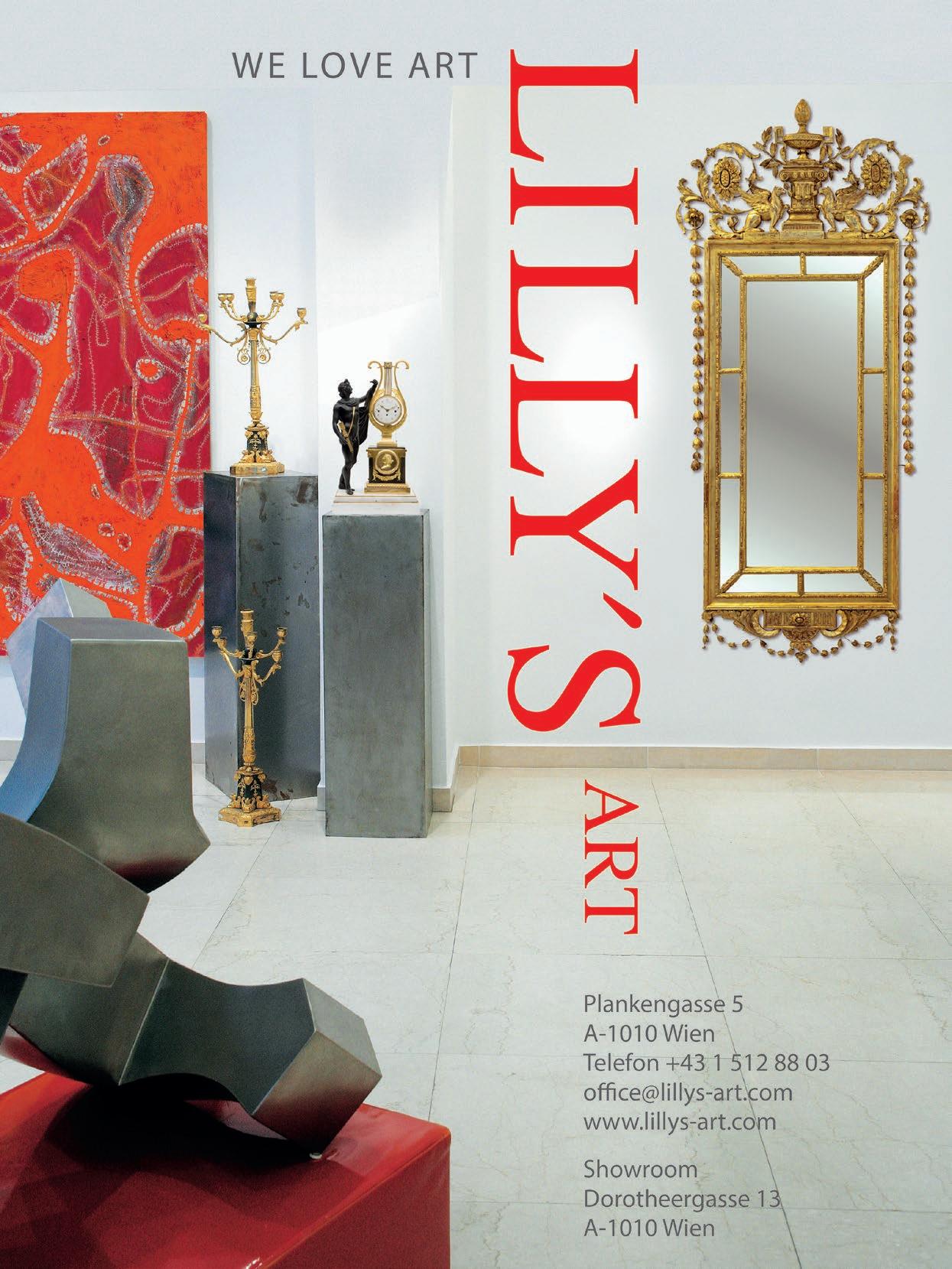
Als „Museum im Museum“ kann man die Kunstkammer Wien, mit der berühmten Saliera von Benvenuto Cellini, bezeichnen. „Der wahre Kosmos an Kunst und Schönheit“ zeigt in 20 Themenschwerpunkten eine Welt des Geistvollen, Kuriosen und Wunderbaren. So finden sich dort die bis zur Barockzeit als besonders kostbar geltenden „exotischen und raren Materialien“. Der Wert der Sammlungen ist unermesslich, die Schönheit und Perfektion der Verarbeitung versetzt alle Besucher in Staunen.

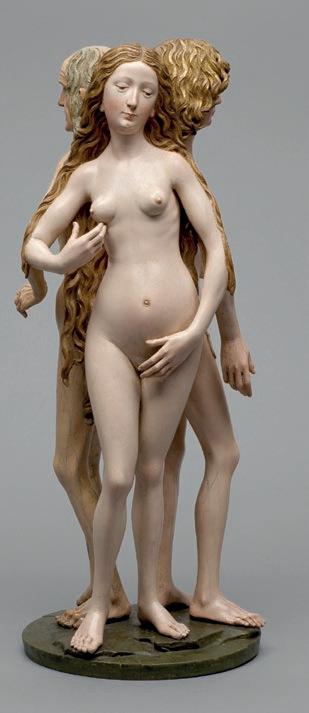

 Kunsthistorisches Museum Wien
Kunsthistorisches Museum Wien

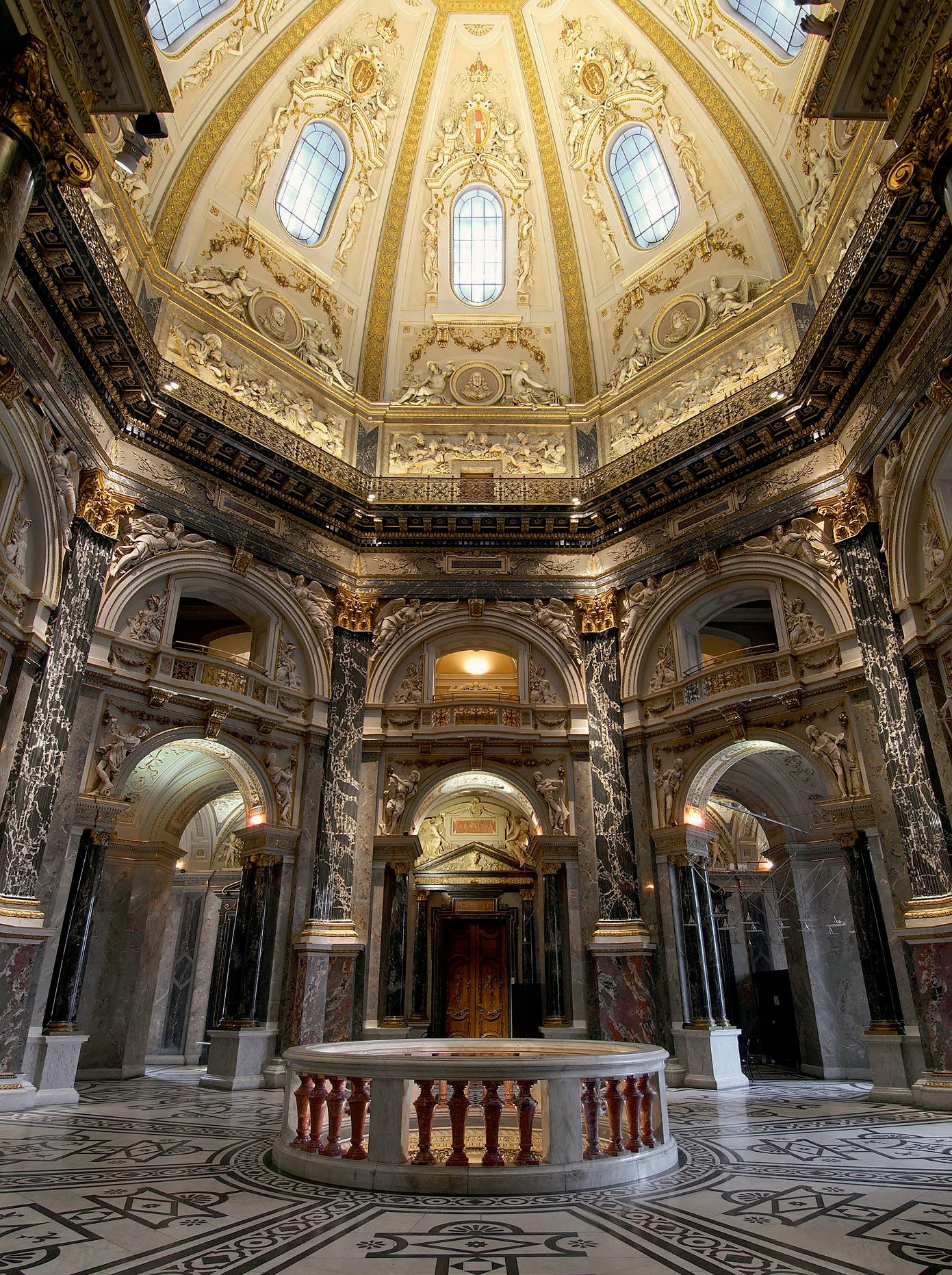
KHM-Museumsverband

The Kunsthistorisches Museum
So vast, diverse, and fascinating is the collection of objects from ancient Egypt, the ancient world, the Middle Ages, and modern times, you could easily spend days viewing the magnificent sculptures and marvelous works by the greatest artists of world history.
Art is the highest good and at the same time the most repulsive,” mused music critic Reger, protagonist in Thomas Bernhard’s novel Old Masters (1985), as he sat on a bench in the Kunsthistorisches Museum. A visit to Vienna’s art history museum is an unforgettable experience in all its varied facets – from the pharaohs to the modern times.
The dimensions inside the museum are already evident from its impressive exterior. Together with its counterpart, the Natural History Museum, the magnificent building is one of the most important major historic structures of the Ringstrasse period. They frame the Maria Theresa memorial statue and form an ensemble monument, which also belongs to the “Historical Centre of Vien-
na” World Cultural Heritage site. Visitors are spellbound as soon as they enter the “Palace of Fine Arts” (1891), commissioned by the Habsburgs and built in the Italian Renaissance style by the renown architects Gottfried Semper and Carl von Hasenauer. Unique major works by Dürer, Raphael, Titian, and Velázquez as well as the world’s largest Bruegel collection are presented in a magnificent setting.
To commemorate the 450th anniversary of the death of the Dutch master of whom only slightly more than 40 paintings have survived, twelve panels of which make the collection of the Kunsthistorisches Museum the largest, the KHM honors Bruegel’s unique work by presenting the world’s first major monographic exhibition.

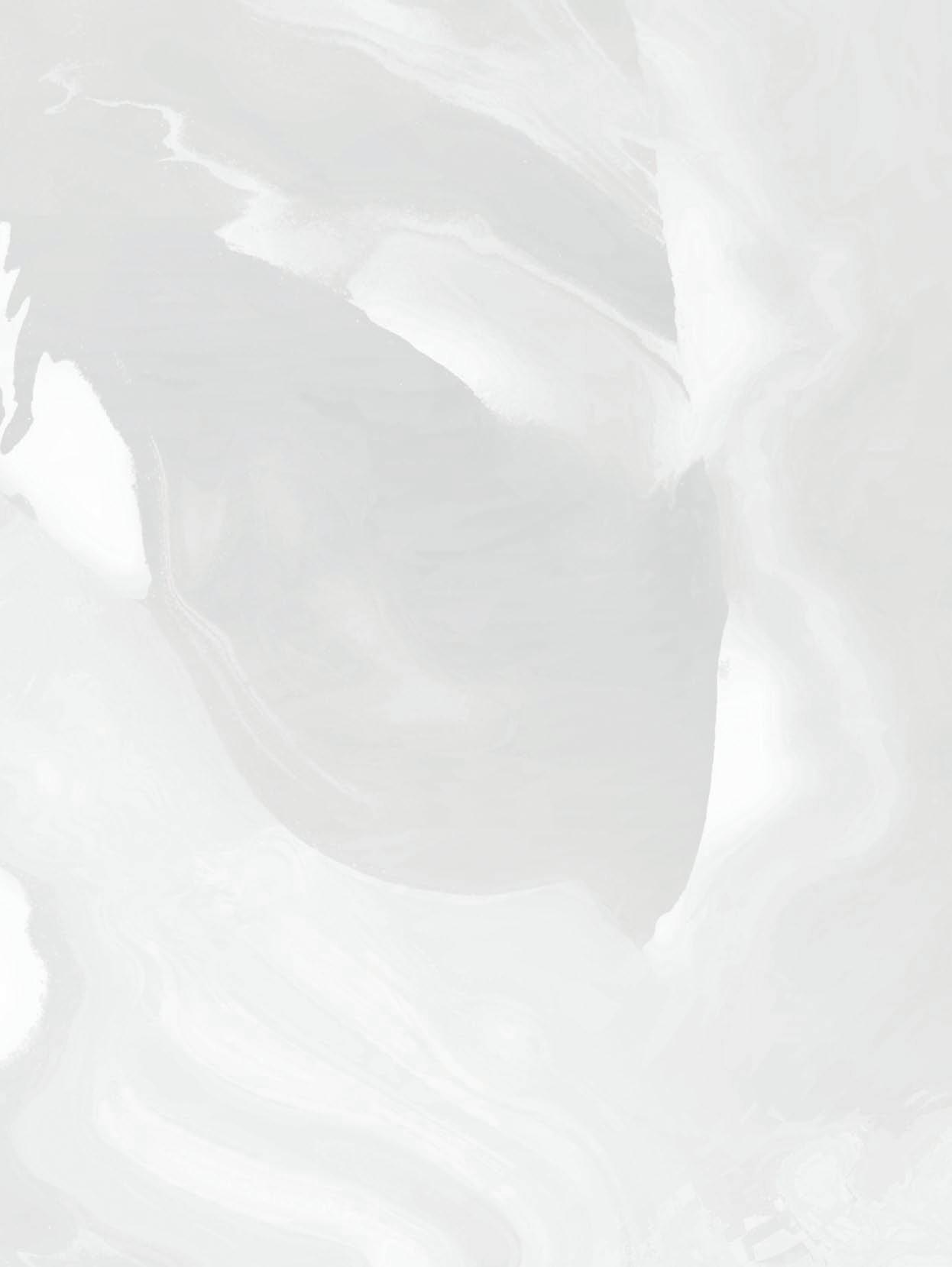 Vienna has a treasure trove of invaluable artifacts thanks to the Habsburgs’ great passion for collecting
Vienna has a treasure trove of invaluable artifacts thanks to the Habsburgs’ great passion for collecting
titled Spitzmaus Mummy in a Coffin and Other Treasures until April 2019. More than four million objects from all fourteen collections were combed through for this exhibition.

The Egyptian and Near Eastern Collection of the Kunsthistorisches Museum is among the world’s most important collections of Egyptian antiquities. The more than 17,000 objects date from a period of almost 4,500 years. The approximately 2,500 objects in the Collection of Greek and Roman Antiquities – from a period spanning more than three millennia – range from the Bronze Age pottery of Cyprus from the 3rd century BC to early medieval artifacts.

The Picture Gallery has positioned itself as one of the greatest and most important venues of its kind, featuring 16th century Venetian painting (Titian, Veronese, Tintoretto), Old Dutch masters (Jan van Eyck, Rogier van der Weyden), as well as works by Vermeer, Rembrandt, Raphael, Caravaggio, Velázquez, along with Italian Baroque painting.
The Kunstkammer Wien, with the celebrated Saliera by Benvenuto Cellini, can best be described as a “museum within a museum”. With 20 thematic focal points, the “veritable cosmos of art and beauty” presents a world of the spiritual, the peculiar, and the wonderful. Thus, “exotic and rare materials” that were considered particularly precious until the Baroque period can be found there. The value of the collections is immeasurable, and the beauty and perfection of the workmanship continue to astonish and amaze all visitors to this unique museum. n
Kunsthistorisches Museum Wien
African Vision
RUTH BAUMGARTE
Im Mittelpunkt der Schau in der Pfeilerhalle steht Baumgartes umfassender Werkkorpus, dem Reisen der Künstlerin in afrikanische Länder wie Ägypten, Südafrika, Kenia, Tansania, Uganda, Äthiopien, Sudan und Simbabwe zugrunde liegen. Die insgesamt rund 70 Ölgemälde, Aquarelle und Graphiken entfalten bei ihrer Betrachtung eine nahezu magische Qualität. Der simbabwische Dichter Chirikure Chirikure sagte über die Künstlerin: „Die Länder Afrikas und seine Völker waren für sie keine Modelle, die es auf der Leinwand festzuhalten galt, sondern ein integraler Bestandteil ihrer Lebensreise.“
MIT DER DEUTSCHEN MALERIN RUTH BAUMGARTE (1923 – 2013) PRÄSENTIERT DIE ALBERTINA EINE HERAUSRAGENDE KÜNSTLERINNENPOSITION DES 20. JAHRHUNDERTS.
Ab den 1950er-Jahren bis ins hohe Alter reiste die Künstlerin über vierzig Mal nach Afrika, wo sie die Menschen aufmerksam beobachtete, sich empathisch in sie einfühlte. Sie interessierte sich für die fremden Kulturen eines damals für europäische Kunstschaffende noch unerschlossenen Kontinents. Zentral für das Verständnis von Ruth Baumgartes Kunst ist das Verhältnis von Mensch und Natur, die Verschmelzung von Figur und Landschaft. Auf Basis schneller Skizzen, die sie vor Ort anfertigte, schuf sie später – wieder zuhause in ihrem Atelier in Deutschland – farbintensive Gemälde, virtuose Aquarelle, ausdrucksstarke Gouachen und Zeichnungen. n
At the center of this presentation in the Columned Hall is Baumgarte’s wide-ranging body of works born of her travels to African countries such as Egypt, South Africa, Kenya, Tanzania, Uganda, Ethiopia, Sudan, and Zimbabwe. These altogether ca. 70 oil paintings, watercolors, and graphic works manifest a near-magical quality when viewed in person. Zimbabwean poet Chirikure Chirikure said of the artist: “She viewed the countries of Africa and their peoples not as models to be immortalized on canvas but as an integral part of her journey through life.”
Beginning in the 1950s and until well into her old age , the artist made over 40 trips to Africa, whose people she attentively observed and empathetically appreciated. She took an interest in the unfamiliar cultures of a continent that had yet to be discovered by European artists at that time. n

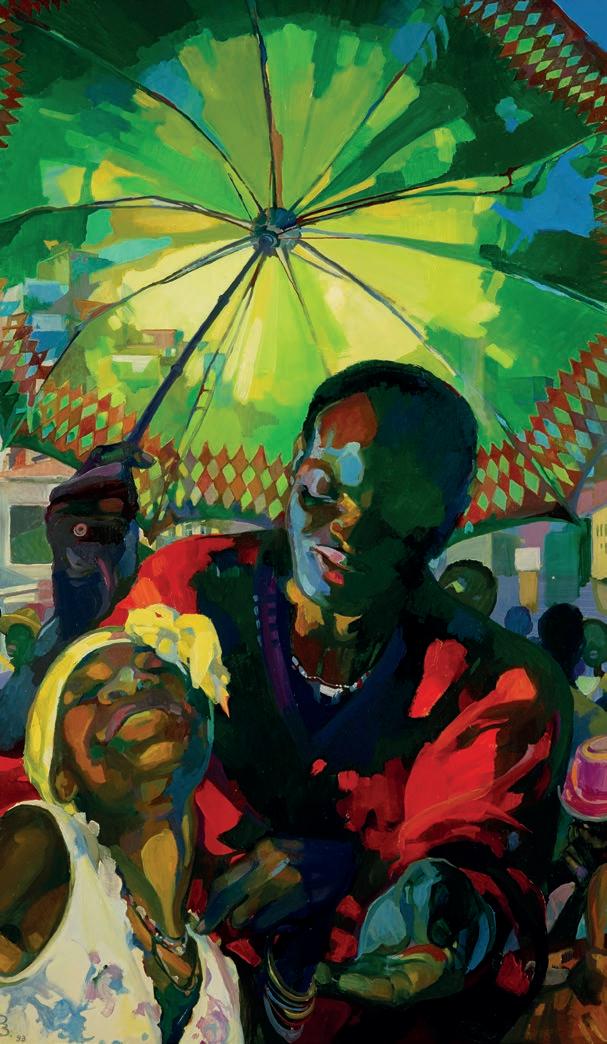 Ruth Baumgarte
Ruth Baumgarte
IT IS WITH WORKS BY THE GERMAN
PAINTER RUTH BAUMGARTE
(1923–2013) THAT THE ALBERTINA MUSEUM SETS OUT TO PRESENT AN OUTSTANDING ARTIST OF THE 20TH CENTURY.
Ruth Baumgarte Misunderstanding 1993 © Kunststiftung Ruth Baumgarte
Ruth Baumgarte Africanvision 1998 © kunststiftung Ruth Baumgarte
Avantgarde und Gegenwart
Werke dieser und vieler anderer österreichischer Künstler befinden sich in der Sammlung des Belvedere und machen die Faszination des Bestandes aus dem 20. sowie dem 21. Jahrhundert aus. Die Ausstellung Avantgarde und Gegenwart bringt eine hochkarätige Auswahl gegenwärtiger und historischer Positionen aus der Sammlung sowie aus der vom Belvedere ver-
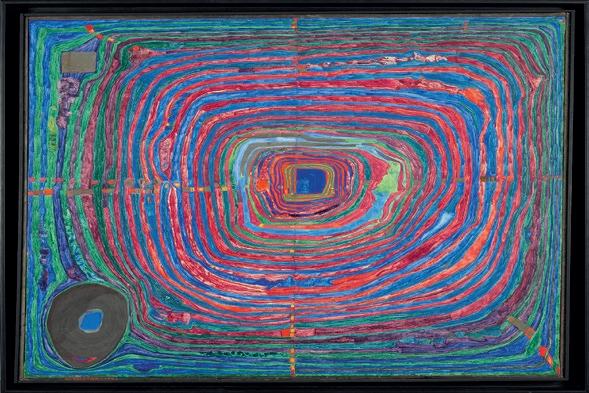

walteten Artothek des Bundes in ein produktives Wechselspiel. Die Sammlung wird als ein dynamisches Gefüge von Konstellationen begriffen, das auf Kontinuitäten und Brüche, Relevanzen und Redundanzen hin befragt wird. Verschiedene Erzählstränge vermitteln Zugänge zur Kunst von den 1930er-Jahren bis heute und zeigen wesentliche Strömungen und Tendenzen auf. n
Avant-Garde and the Contemporary
Works by these and many other Austrian artists in the collection account for the allure of the Belvedere’s holdings from the 20th and 21st centuries. The exhibition Avant-Garde and The Contemporary brings a distinguished selection of contemporary and historical artistic approaches from the collection as well as from the Artothek des Bundes, administered by the Belvedere, into productive correspondence. The collection is conceived as a dynamic structure of constellations, examined for continuities and ruptures, relevance and redundancy. Through multiple narrative strands, the show provides insights into art since the 1930s and highlights key artistic currents and tendencies. n
 Die Sammlung Belvedere von Lassnig bis Knebl
The Belvedere Collection from Lassnig to Knebl
GRETA FREIST, FRIEDENSREICH HUNDERTWASSER, MARIA LASSNIG, PADHI FRIEBERGER, GÜNTER BRUS, VALIE EXPORT HEIMO ZOBERNIG, ELKE SILVIA KRYSTUFEK, ASHLEY HANS SCHEIRL, AND JAKOB LENA KNEBL:
Maria Lassnig Doppelselbstporträt mit Kamera 1974 © Maria Lassnig Stiftung Bildrecht, Wien 2021 Foto Johannes Stoll
GRETA FREIST, FRIEDENSREICH HUNDERTWASSER, MARIA LASSNIG, PADHI FRIEBERGER, GÜNTER BRUS, VALIE EXPORT, HEIMO ZOBERNIG, ELKE SILVIA KRYSTUFEK, ASHLEY HANS SCHEIRL UND JAKOB LENA KNEBL:
Ashley Hans Scheirl Neoliberal Surrealist Belvedere, Wien Johannes Stoll Friedensreich HundertwasserDer große Weg © 2021 Namida AG Glarus Schweiz
Die Sammlung Belvedere von Lassnig bis Knebl
The Belvedere Collection from Lassnig to Knebl
GRETA FREIST, FRIEDENSREICH HUNDERTWASSER, MARIA LASSNIG, PADHI FRIEBERGER, GÜNTER BRUS, VALIE EXPORT HEIMO ZOBERNIG, ELKE SILVIA KRYSTUFEK, ASHLEY HANS SCHEIRL, AND JAKOB LENA KNEBL:
Maria Lassnig Doppelselbstporträt mit Kamera 1974 © Maria Lassnig Stiftung Bildrecht, Wien 2021 Foto Johannes Stoll
GRETA FREIST, FRIEDENSREICH HUNDERTWASSER, MARIA LASSNIG, PADHI FRIEBERGER, GÜNTER BRUS, VALIE EXPORT, HEIMO ZOBERNIG, ELKE SILVIA KRYSTUFEK, ASHLEY HANS SCHEIRL UND JAKOB LENA KNEBL:
Ashley Hans Scheirl Neoliberal Surrealist Belvedere, Wien Johannes Stoll Friedensreich HundertwasserDer große Weg © 2021 Namida AG Glarus Schweiz
Die Wiege des Museums – im Kunsthistorischen Museum Wien
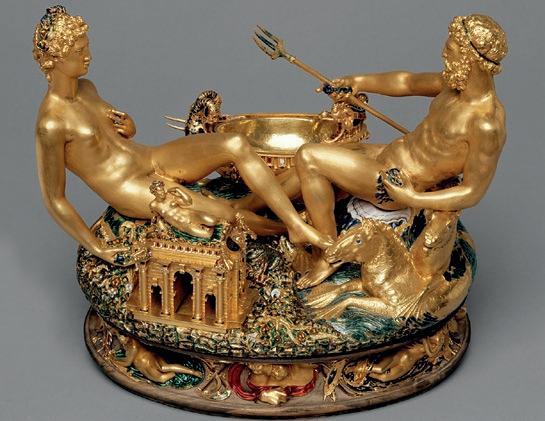
KUNSTKAMMER WIEN
Sie ist weltweit die bedeutendste ihrer Art: Hier erlebt man ein »Museum im Museum«: In nach Themenschwerpunkten neu gestalteten Räumen eröffnet sich eine Welt des Schönen und Geistvollen, Kuriosen und Wunderbaren. Die Kunst- und Wunderkammern der Renaissance und des Barock waren enzyklopädische Universalsammlungen, die das gesamte Wissen ihrer Zeit zu erfassen versuchten. Vor allem das Seltene, Kuriose und Außergewöhnliche galt als erstrebenswert. Vom späten Mittelalter bis zur Barockzeit sammelten die Habsburger Kaiser und Fürsten hier exotische und rare Materialien, denen
man oft auch magische Wirkungen zuschrieb – wie edle Steine, Straußeneier, Korallen, oder Haifischzähne, die man für Drachenzungen hielt. Die Künstler schufen aus diesen Naturprodukten virtuose Kunstkammerstücke. Zu den Höhepunkten der Kunstkammer Wien zählen herausragende Goldschmiedearbeiten wie die berühmte Saliera von Benvenuto Cellini, Spitzenleistungen der Skulptur wie die Krumauer Madonna, meisterhafte Bronzestatuetten, filigrane und bizarre Elfenbeinarbeiten, virtuose Steingefäße, aber auch wertvolle Uhren, komplizierte Automaten, merkwürdige wissenschaftliche Instrumente und kostbare Spiele. n
The Cradle of the Museum
The Kunstkammer Wien is the most important collection of its kind in the world. Come and see a »museum within the museum«: twenty galleries invite you to experience a world of beauty and wit, curiosities and wonder. The Kunst- und Wunderkammern (arts and natural wonders rooms) of the Renaissance and Baroque periods were encyclopaedic, universal collections that attempted to reflect the entire knowledge of the day. Particularly desirable were rare, curious and unusual objects.
From the late Middle Ages to the Baroque, Habsburg emperors and archdukes collected exotic and uncommon materials, to which they often ascribed magical powers, such as precious stones, ostrich eggs, coral and shark’s teeth, which were considered to be dragon’s tongues. From these natural products, artists created virtuoso works of art. Among its highlights are examples of fabulous goldsmith work such as the celebrated Saliera by Benvenuto Cellini, outstanding sculptures such as the Krumau Madonna, magnificent bronze statuettes, delicate and bizarre ivories and precious stone vessels as well as valuable clocks, elab-

orate automatons, strange scientific instruments, and sumptuous gameboards. n
 MUSCHELSCHALE, SOG. DRACHENSCHALE 1565/1570
Künstler: Gasparo Miseroni © Kunsthistorisches Museum Wien, Kunstkammer
SOGENANNTE SALIERA 1540-1543, Benvenuto Cellini © Kunsthistorisches Museum Wien, Kunstkammer
KÄSTCHEN Vor 1542, © Kunsthistorisches Museum Wien, Kunstkammer
MUSCHELSCHALE, SOG. DRACHENSCHALE 1565/1570
Künstler: Gasparo Miseroni © Kunsthistorisches Museum Wien, Kunstkammer
SOGENANNTE SALIERA 1540-1543, Benvenuto Cellini © Kunsthistorisches Museum Wien, Kunstkammer
KÄSTCHEN Vor 1542, © Kunsthistorisches Museum Wien, Kunstkammer
Wien IX, Berggasse 19. An dieser Adresse lebte und arbeitete Sigmund Freud 47 Jahre, ehe er 1938 vor den Nationalsozialisten fliehen musste. Seit 1971 befindet sich hier das Sigmund Freud Museum, das sich nach der 2020 abgeschlossenen Sanierung und Erweiterung Freuds vielschichtigem kulturellen Erbe widmet: Sein Leben und Werk stehen im Zentrum der Dauerausstellung, die alle Räume, in denen Freud mit seiner Familie lebte und arbeitete, präsentiert: Das Mezzanin mit der Privatwohnung und den Ordinationen von Sigmund und Anna Freud ebenso wie seine „Erste Ordination“ im Hochparterre. Ein neu errichtetes Stiegenhaus zeigt die Geschichte des Hauses und die seiner Bewohnerinnen und Bewohner. Noch bis 10. April 2023 beleuchtet die Sonderausstellung „SURREAL! Vorstellung neuer Wirklichkeiten“ mit 100 Werken von (u.a.) Salvador Dalí, Giorgio de Chirico, Max Ernst, Pablo Picasso, Toyen und Dorothea Tanning die vielschichtige wie spannungsreiche Beziehung zwischen Surrealismus und Psychoanalyse. n ©
Vienna IX, Berggasse 19. It was at this address that Sigmund Freud would live and work for 47 years before being forced to flee from the Nazis in 1938. Since 1971, the address has been home to the
FREUD MUSEUM DAS
SIGMUND
www.freud-museum.at
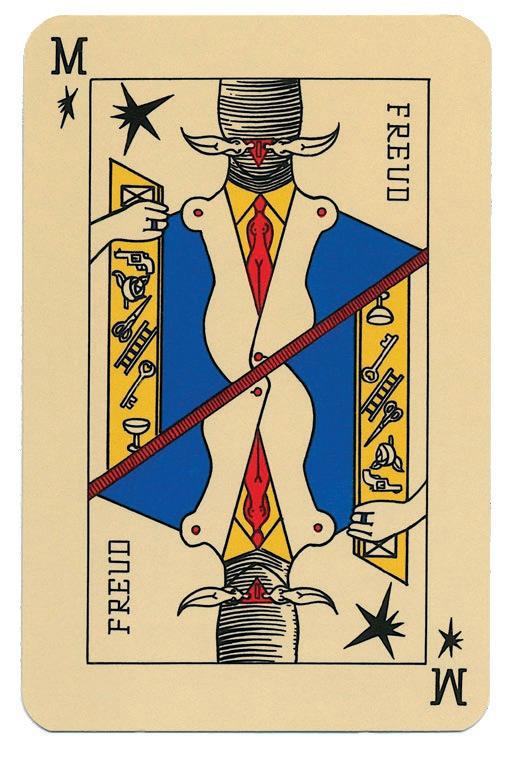
Sigmund Freud Museum, a venue that has been dedicated to Freud’s multi-layered cultural legacy following its renovation and expansion, which was completed in 2020. The permanent exhibition centers on Freud’s life and work, showcasing all the rooms in which he resided with his family and conducted his practice. The mezzanine includes the private apartment and the offices of Sigmund and Anna Freud, as well as his “first practice” on the upper ground floor. A reconstructed stairwell illustrates the history of the building and that of its residents. The special exhibition „SURREAL! Imagining New Realities“ continues until April 10, 2023, and features 100 works by artistic greats that include Salvador Dalí, Giorgio de Chirico, Max Ernst, Pablo Picasso, Toyen, and Dorothea Tanning. The exhibition sheds light on the complex and tense relationship between surrealism and psychoanalysis.

n
Deutsches Spielkartenmuseum
Herbert Bayer, The Lonely Metropolitan, 1973 (1936) © Bildrecht, Wien 2022
A UNIQUE SLICE OF TRADITION THAT IS ALSO LISTED AS AN INTANGIBLE WORLD HERITAGE
THE VIENNESE COFFEEHOUSE
Now more than ever, people yearn for a brief respite from the hectic pace of everyday life. Even writers like Thomas Bernhard – who was practically part of the inventory of a coffeehouse in the citycenter of Vienna and dauntlessly compared the coffeehouse with a park where both tranquility and diversion can be found – as well as Stefan Zweig, treasured the “cozy home of the ‚Melange‘ and the ‚Großer Brauner’” beyond all measure.
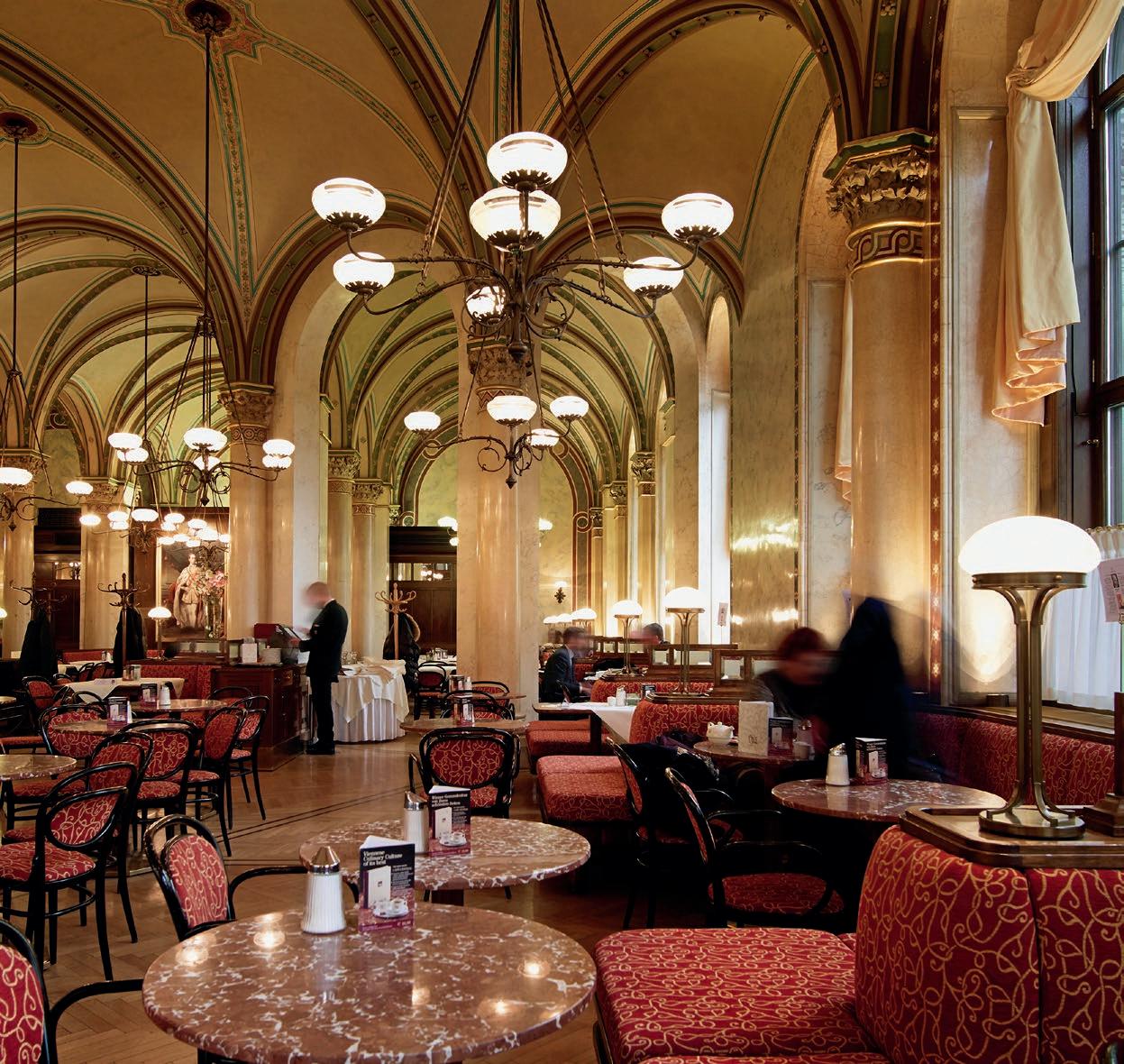 Café Central
WienTourismus Christian Stemper
Café Central
WienTourismus Christian Stemper
Nonetheless, opinions are divided regarding the origin of the coffeehouse, and it is difficult to distinguish between fact and legend. People often like to tell the following anecdote: Disguised as a Turk, Georg Franz Kolschitzky slipped through enemy lines at the end of the Turkish siege in order to deliver an important message to Charles of Lorraine. And for this heroic deed, he was richly rewarded: a plot of land, a trade license, and bags with the mysterious dark beans taken from the treasures of the Turks. From these materials, the first Viennese coffeehouse was built near St. Stephen’s Cathedral in Vienna. “And Kolschitzky brews up the first Turkish coffee in no time,” was the popular saying. After all, the Viennese have truly turned coffee drinking into culture – an attitude towards life that can still be felt in many of the traditional coffeehouses today: Landtmann, Demel K. &
K. Hofzuckerbäcker, Café Museum, Café Diglas, and Café Prückel are prime examples. You’ll find the “coffeehouse literati” and artists at Café Engländer, another coffee cult institution next to Hawelka.

The luxurious gardens attract visitors in the summer with al fresco iced coffee and cake. It was Empress Maria Theresa who first granted permission for establishments to offer outdoor seating, and gave Gianni Tarroni permission to put up chairs in front of his café on Graben – “Giannis Garten.” And thus, the Viennese Schanigarten was born. The Viennese coffeehouse is enjoying a boom like never before. While cafés once provided the possibility to be reached by phone, to work without feeling alone, and yet still be in the midst of the hustle and bustle, modern Viennese cafés offer Wi-Fi, DJ sounds, and unique roasts. n
 Café Sperl
Café Demel
Café Sperl
Café Demel
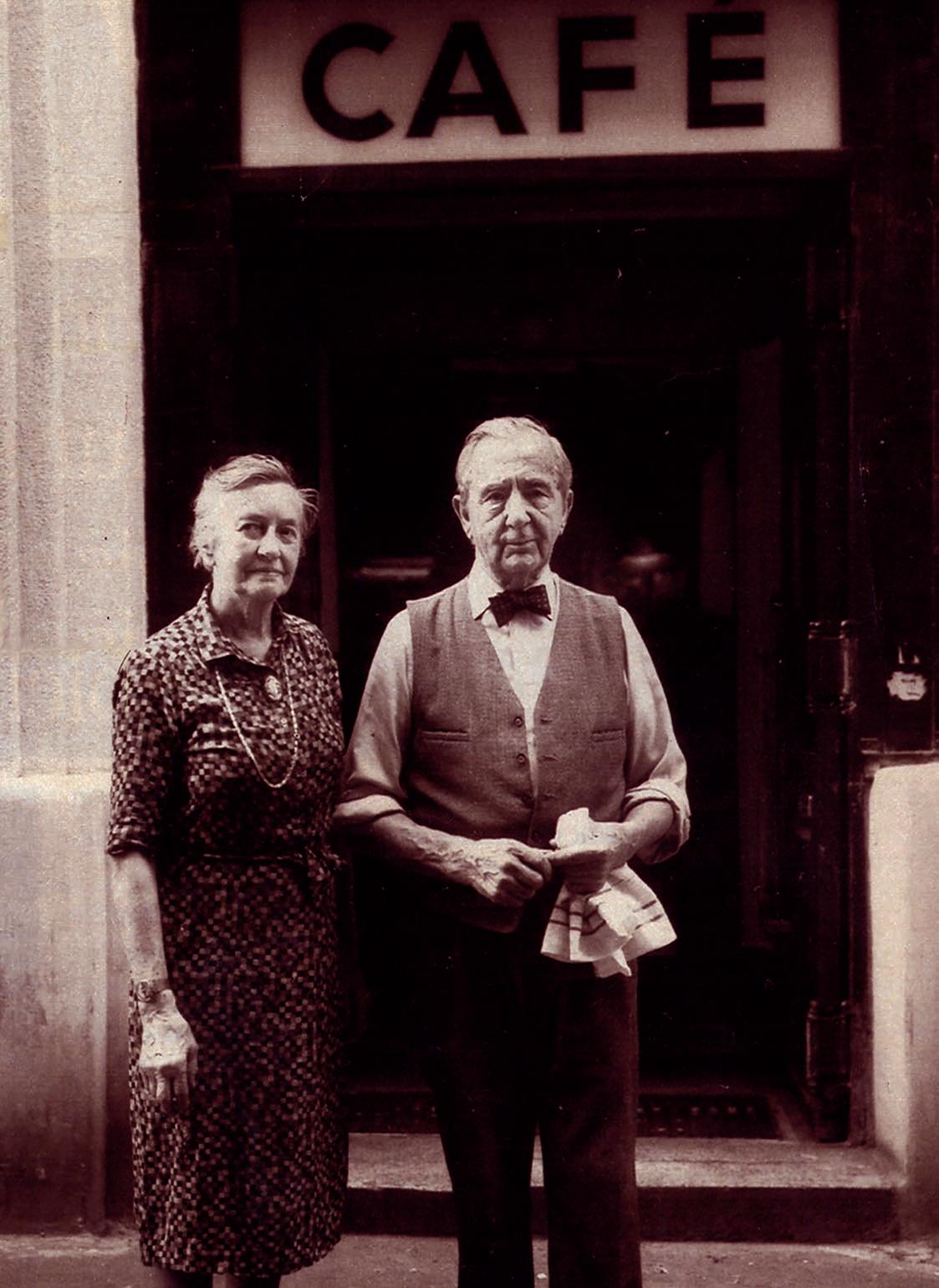
WÄRE WIEN OHNE DAS
LEOPOLD UND JOSEFINE ERÖFFNETEN BEREITS EINEN TAG NACH IHRER HOCHZEIT 1936 DAS CAFÉ ALT WIEN IN DER BÄCKERSTRASSE UND ZOGEN DREI JAHRE SPÄTER IN DIE DOROTHEERGASSE, WO SCHNELL DER TREFFPUNKT FÜR LITERATEN UND KÜNSTLER SCHLECHTHIN ENTSTAND, DESSEN ATMOSPHÄRE BIS HEUTE ERLEBBAR IST. DAS HAWELKA IST AUCH HEUTE NOCH EINE INSTITUTION UND DIE BOHNEN DES WOHL BEKANNTESTEN KAFFEEHAUSES ÖSTERREICHS GIBT ES NUN AUCH FÜR ZU HAUSE.
WAS
HAWELKA?
What would Vienna be without the Hawelka?
In 1936, just one day after their wedding, Leopold and Josefine opened the Café Alt Wien on Bäckerstraße, moving to Dorotheergasse three years later. The venue quickly became the preferred meeting place of writers and artists, and that atmosphere is still palpable today. Café Hawelka is an institution in its own right, and now the beans of Austria’s most famous coffeehouse can also be enjoyed at home.


Alongside painters from the school of “Fantastic Realism,” the members of Albert Paris Gütersloh’s Art Club used to gather at Hawelka, while avant-garde poets and writers of the Wiener Gruppe (Vienna Group) such as H.C. Artmann and Konrad Bayer refined and elaborated their experiments with language at its tables. Himself an impassioned painter, Leopold soon began collecting the works of his talented guests and using them to decorate the walls of the café. Quite often the artists would even use their work to cover the bill when they were short on cash. Posters still cover one wall of the establishment, aspiring artists can still sense the living room feeling just as vibrantly as it ever was, and the Buchteln (filled
sweet rolls) never disappoint. The roasting business also began with “Leopold and Josefine.” Inspired by his grandparents, Amir Hawelka created products intended to spread the coffee culture of the famous café beyond its four walls. Top varieties cultivated in regions all over the world are processed, blended, and roasted following the family’s own recipe and in the traditional Viennese style. Now gourmets can enjoy unadulterated natural quality, full of flavor and free of additives. The Hawelka coffee roasting facility and bar sell the exquisite beans just across the street from the coffeeshop. With keen architectural finesse that reflects refined materials on every level, a veritable “coffee cathedral” with a sophisticated ambiance was born. n
Im Hawelka kamen die Mitglieder des „Art-Club“ von Albert Paris Gütersloh zusammen, hier feilten Mitglieder der „Wiener Gruppe“ wie H.C. Artmann und Konrad Bayer an ihren Sprachexperimenten und die „Phantastischen Realisten“ fanden eine Wirkungsstätte. Selbst leidenschaftlicher Maler begann Leopold bald damit, die Werke seiner talentierten Gäste zu sammeln und damit die Wände des Cafés zu schmücken. Oft hatten die Künstler sogar damit ihre Konsumation beglichen, wenn sie zu knapp bei Kasse waren. Eine Wand des Etablissements ist noch immer mit Postern bedeckt, die Wohnzimmeratmosphäre für die Künstlergilde strahlt wie früher und auch die Buchteln sind von gewohnter bester Qualität.
Auch bei der Rösterei begann alles mit „Leopold und „Josefine“. Enkel Amir Hawelka ließ sich von den Großeltern inspirieren und schuf Produkte, die die Kaffeekultur des berühmten Hauses auch außerhalb verbreiten sollen. Spitzensorten aus Anbaugebieten in aller Welt werden nach eigenem Rezept in traditioneller „Wiener Art“ veredelt, gemischt und geröstet. Ohne Zusatzstoffe kommt damit ein reines Naturprodukt mit vollem Geschmack auf den Tisch des Genießers. Für den Verkauf der exquisiten Bohnen wurde schräg gegenüber dem Kaffee die Kaffeerösterei Hawelka samt Bar eingerichtet. Mit viel architektonischem Feingespür und Verspiegelungen von edlen Materialien in allen Ebenen wurde eine „Kaffee-Kathedrale“ mit feinstem Ambiente geschaffen. n
So isst und trinkt man in Wien
ALS EINZIGE STADT DER WELT IST WIEN NAMENSGEBER EINES EIGENSTÄNDIGEN SPEISEN-STILS, DER WIENER KÜCHE. AUS EINFLÜSSEN VERSCHIEDENSTER LÄNDER KOMPONIERT MAN IN WIEN EINE ABWECHSLUNGSREICHE KÜCHE.
Die Wiener Gasthäuser und Restaurants sind Orte der Begegnung und des Austauschs. Hier werden Kontakte geknüpft, Politik gemacht, gelacht, geflirtet und natürlich großartig gegessen. Gastfreundschaft wird in Wien schon seit jeher großgeschrieben. Beim Essen und Trinken trifft man sich. Und nicht umsonst klingt jedes Business-Treffen mit einem Restaurantbesuch aus. Was Wien so besonders macht: natürlich die Wiener Küche. Unübertroffen in ihrer Vielfalt und mit ihren Einflüssen aus den ehemaligen Ländern der Habsburger-Monarchie.

Mit Traditionsgerichten vom Wiener Schnitzel bis zum Gulasch, und als Dessert natürlich ein Strudel. Und nicht zuletzt hat jedes Wiener Restaurant eine gute Seele, einen Wirt, einen Patron oder eine herzliche Chefköchin, die für besondere Gastfreundschaft sorgen – Perfekte Treffpunkte für Einheimische gleichermaßen wie für Touristen und Geschäftsreisende. So unterschiedlich die Lokale sind – eines ist ihnen gemeinsam: der Fokus auf hochwertige Zutaten und das Bewusstsein auf traditionelle Küche, bei manchen auch mit einem ordentlichen Pfiff Modernität. n
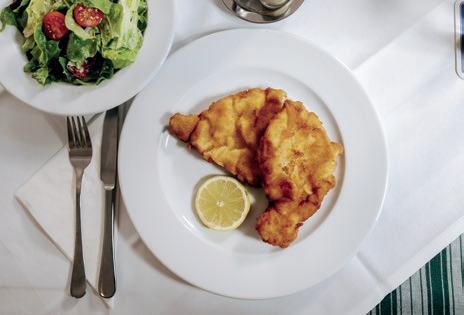
Die wiener Küche
Dining in Vienna Viennese cuisine

Viennese Cuisine is the only cuisine in the world to be named after a city. Viennese chefs draw on influences from various countries to conjure up exciting dishes.
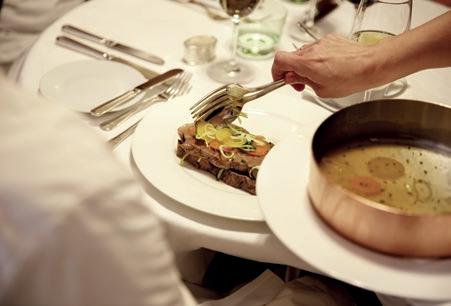
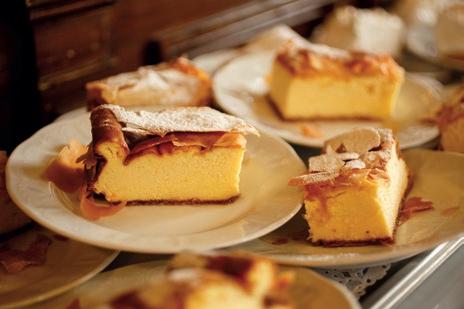
Vienna's inns and restaurants are places of meeting and exchange. They are where contacts are made, policy created, where people laugh, flirt and, of course, dine in grand style. Hospitality has always been a priority in Vienna. People meet over food and drink. And it's no coincidence that every business meeting ends with a visit to a restaurant. What makes Vienna so special? Viennese cuisine, of course! Unsurpassed in its variety and influenced by the former countries of the Habsburg mon -
archy. With traditional dishes ranging from Wiener schnitzel to goulash. And, of course, each Viennese restaurant has a good soul, a host, a patron or a cordial head chef who delivers a special level of hospitality – making them the perfect meeting places for locals as well as for tourists and business travelers. As different as the eateries are – they all have something in common: a focus on high-quality ingredients and an awareness of traditional cuisine, with some also offering a decent splash of modernity. n

In guter Nachbarschaft mit dem Hotel THE AUMAURIS
HERRENMODE STEPANEK
KLASSISCHE MODE IN HÖCHSTER QUALITÄT GEPAART MIT HERVORRAGENDER, PERSÖNLICHER BERATUNG MACHEN DAS SCHÖNE GESCHÄFT AM RING UNVERZICHTBAR FÜR DEN ELEGANTEN HERRN.
Familie Stepanek, die das Geschäft in 3. Generation führt, importiert aus England, Irland, Frankreich und Italien edle Sakkos und Westen, sportliche und elegante Hosen, Hemden aus feinster Baumwolle, Pullover aus schmeichelndem Kaschmir, Alpaka und Schurwolle, sowie alle möglichen Accessoires von Krawatten, Socken bis hin zu Hosenträgern, Manschettenknöpfen und Hüten.
Zahlreiche Stammkunden aus dem In- und Ausland kommen regelmäßig in das schöne Geschäft, um für sich das passende und qualitätsvolle Outfit zu besorgen. Wer klassische Herrenmode liebt, ist bei Stepanek genau richtig. Hier am Ring, gegenüber der Oper, erfüllt man jede Vorstellung, die man von einem klassischen Herrenausstatter haben kann. Entsprechend wurde bei der aktuellen Renovierung und Erweiterung auch dem historischen, von Adolf Loos entworfenen Portal, besondere Wertschätzung entgegengebracht. n
THE AUMAURIS, the hotel in a trendy upscale neighborhood

HERRENMODE STEPANEK
Traditional men’s fashion of the highest quality, combined with excellent personal service and consultation make the charming shop on the Ring indispensable for the elegant gentleman.

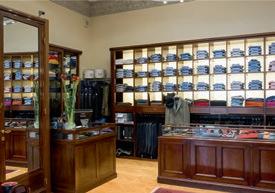
The Stepanek family, now in its third generation of company management, sources and imports select, high quality jackets, sporty, elegant trousers, the finest cotton shirts, flattering cashmere knitwear, alpaca and lambswool sweaters and cardigans, as well as every sort of men’s accessories including ties, socks, braces, cufflinks and hats, from England, Ireland, France, and Italy.

Numerous regular customers from Austria and abroad have come to rely on the selection and expertise of this unique shop to find the right outfit to match the occasion.
If you love traditional fashion, Stepanek is the right place to find high-quality menswear. Centrally situated on the Ring opposite the opera, Stepanek will fulfill all your expectations for a traditional gentlemen’s outfitter. The same degree of meticulous attention has been paid to the historical renovation and extension of the store’s portal designed by Adolf Loos.

n
THE
AUMAURIS
Es begann als Idee mit einem Schmetterling...
DER NEUE HOT-SPOT IN WIENS BESTER LAGE - AM PRESTIGETRÄCHTIGEN KÄRNTNER RING ZWISCHEN DER STAATSOPER UND DEM MUSIKVEREIN.
Der Name The Amauris leitet sich von der SchmetterlingsArt „Amauris“ ab und steht für Eleganz und Schönheit in jeder Ecke! Ganz nach dem Motto „Explore Beauty“ begeistert The Amauris Vienna mit besonderen Details, gestaltet von Innenarchitekt Nikola Arambasic. So bieten etwa alle Hotelzimmer hochwertigste Oberflächen, luxuriöses Interior und ein Smart-Room-System. Im hauseigenen Glasswing Restaurant – ebenfalls benannt nach einer Schmetterlings-Art – sowie der angrenzenden Bar und dem Bistro kommen auch anspruchsvolle Gaumen auf ihre Kosten: Von Frühstück und Lunch bis hin zum Abendessen bieten Restaurant und Bistro nicht nur für Hotel -
gäste ein wahres Gourmet-Erlebnis. Auch der Wellness-Faktor kommt im The Amauris Vienna besonders zur Geltung. Mit einem neu gestalteten SPA-Bereich inklusive Pool mit Gegenstromanlage, Finnischer Sauna, Behandlungsraum sowie Fitnesscenter lässt es sich bestens entspannen. The Amauris Vienna bietet ein einzigartiges Erlebnis mitten im Herzen Wiens. Interior-Fans, Lifestyle-Liebhaber sowie Gourmets dürfen sich auf exklusives Service, hochwertiges Design, feinste Details sowie ein außergewöhnliches Geschmacks-Erlebnis freuen. n

It all started as an idea with a butterfly....
} THE AMAURIS VIENNA {


The new hot spot situated in Vienna’s prime location – on the prestigious Kärntner Ring between the State Opera and the Musikverein.

The Amauris takes its name from the “Amauris” butterfly and is synonymous with elegance and beauty wherever you look! In the spirit of its “Explore Beauty” motto, The Amauris Vienna captivates guests with distinctive details conceived by interior designer Nikola Arambasic. An example? Every hotel room features top-quality surface treatments, luxurious interiors, and a smart-room system. The in-house Glasswing Restaurant – likewise named after a species of butterfly – as well as the adjacent bar and bistro cater to even the most discerning palates. Whether breakfast, lunch, or dinner, the restaurant and bistro deliver a
The Amauris Vienna
true gourmet experience, for hotel guests and everyone else, too. Another aspect The Amauris Vienna knows how to emphasize is the wellness factor. With a newly designed spa area, including a pool with a counter-current system, a Finnish sauna, a treatment room, and a fitness center, it’s a great place to relax.
The Amauris Vienna offers a unique experience right in the heart of Vienna. Interior design fans, lifestyle enthusiasts, and gourmets alike will enjoy exclusive service, high-quality design, exquisite craftsmanship, and an exceptional culinary experience. n











 © Starpix
Alexander Tuma
© Starpix
Alexander Tuma

 © Michael Poehn
© Michael Poehn














 © Michael Pöhn
© Michael Pöhn










 © Salzburger Festspiele Monika Rittershaus2
© Salzburger Festspiele Monika Rittershaus2
































 Kunsthistorisches Museum Wien
Kunsthistorisches Museum Wien




 Vienna has a treasure trove of invaluable artifacts thanks to the Habsburgs’ great passion for collecting
Vienna has a treasure trove of invaluable artifacts thanks to the Habsburgs’ great passion for collecting



 Ruth Baumgarte
Ruth Baumgarte


 Die Sammlung Belvedere von Lassnig bis Knebl
The Belvedere Collection from Lassnig to Knebl
GRETA FREIST, FRIEDENSREICH HUNDERTWASSER, MARIA LASSNIG, PADHI FRIEBERGER, GÜNTER BRUS, VALIE EXPORT HEIMO ZOBERNIG, ELKE SILVIA KRYSTUFEK, ASHLEY HANS SCHEIRL, AND JAKOB LENA KNEBL:
Maria Lassnig Doppelselbstporträt mit Kamera 1974 © Maria Lassnig Stiftung Bildrecht, Wien 2021 Foto Johannes Stoll
GRETA FREIST, FRIEDENSREICH HUNDERTWASSER, MARIA LASSNIG, PADHI FRIEBERGER, GÜNTER BRUS, VALIE EXPORT, HEIMO ZOBERNIG, ELKE SILVIA KRYSTUFEK, ASHLEY HANS SCHEIRL UND JAKOB LENA KNEBL:
Ashley Hans Scheirl Neoliberal Surrealist Belvedere, Wien Johannes Stoll Friedensreich HundertwasserDer große Weg © 2021 Namida AG Glarus Schweiz
Die Sammlung Belvedere von Lassnig bis Knebl
The Belvedere Collection from Lassnig to Knebl
GRETA FREIST, FRIEDENSREICH HUNDERTWASSER, MARIA LASSNIG, PADHI FRIEBERGER, GÜNTER BRUS, VALIE EXPORT HEIMO ZOBERNIG, ELKE SILVIA KRYSTUFEK, ASHLEY HANS SCHEIRL, AND JAKOB LENA KNEBL:
Maria Lassnig Doppelselbstporträt mit Kamera 1974 © Maria Lassnig Stiftung Bildrecht, Wien 2021 Foto Johannes Stoll
GRETA FREIST, FRIEDENSREICH HUNDERTWASSER, MARIA LASSNIG, PADHI FRIEBERGER, GÜNTER BRUS, VALIE EXPORT, HEIMO ZOBERNIG, ELKE SILVIA KRYSTUFEK, ASHLEY HANS SCHEIRL UND JAKOB LENA KNEBL:
Ashley Hans Scheirl Neoliberal Surrealist Belvedere, Wien Johannes Stoll Friedensreich HundertwasserDer große Weg © 2021 Namida AG Glarus Schweiz


 MUSCHELSCHALE, SOG. DRACHENSCHALE 1565/1570
Künstler: Gasparo Miseroni © Kunsthistorisches Museum Wien, Kunstkammer
SOGENANNTE SALIERA 1540-1543, Benvenuto Cellini © Kunsthistorisches Museum Wien, Kunstkammer
KÄSTCHEN Vor 1542, © Kunsthistorisches Museum Wien, Kunstkammer
MUSCHELSCHALE, SOG. DRACHENSCHALE 1565/1570
Künstler: Gasparo Miseroni © Kunsthistorisches Museum Wien, Kunstkammer
SOGENANNTE SALIERA 1540-1543, Benvenuto Cellini © Kunsthistorisches Museum Wien, Kunstkammer
KÄSTCHEN Vor 1542, © Kunsthistorisches Museum Wien, Kunstkammer


 Café Central
WienTourismus Christian Stemper
Café Central
WienTourismus Christian Stemper

 Café Sperl
Café Demel
Café Sperl
Café Demel


















